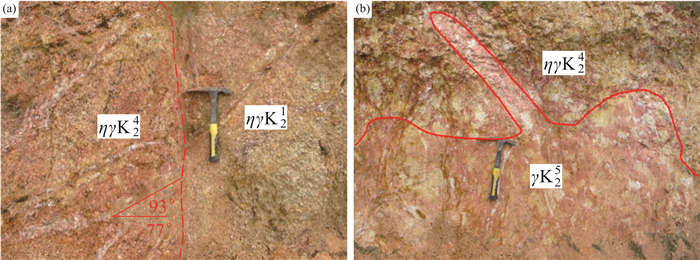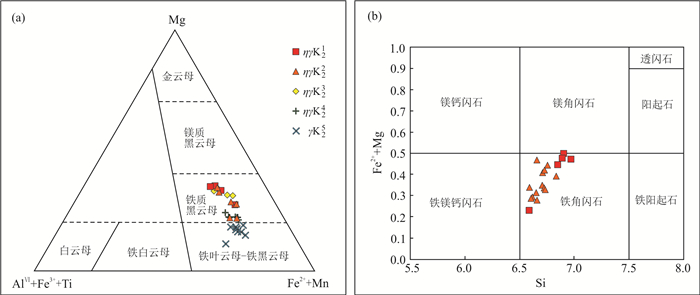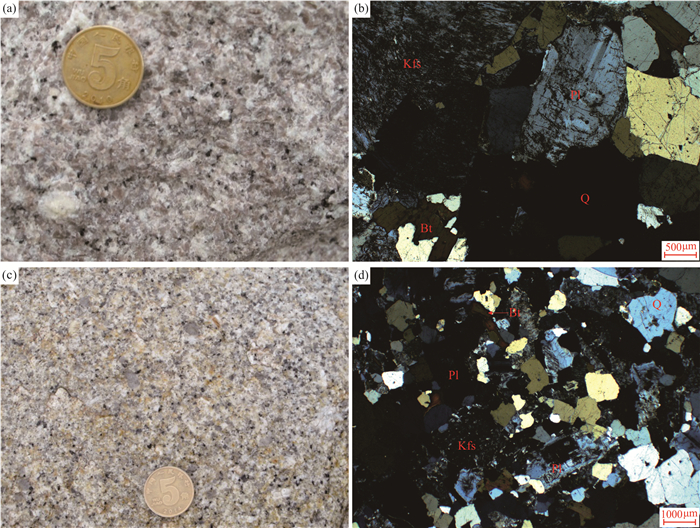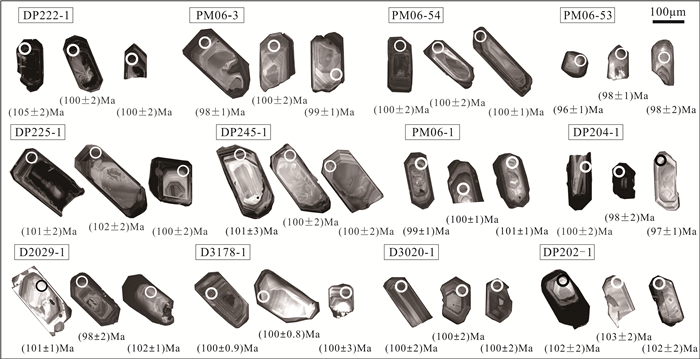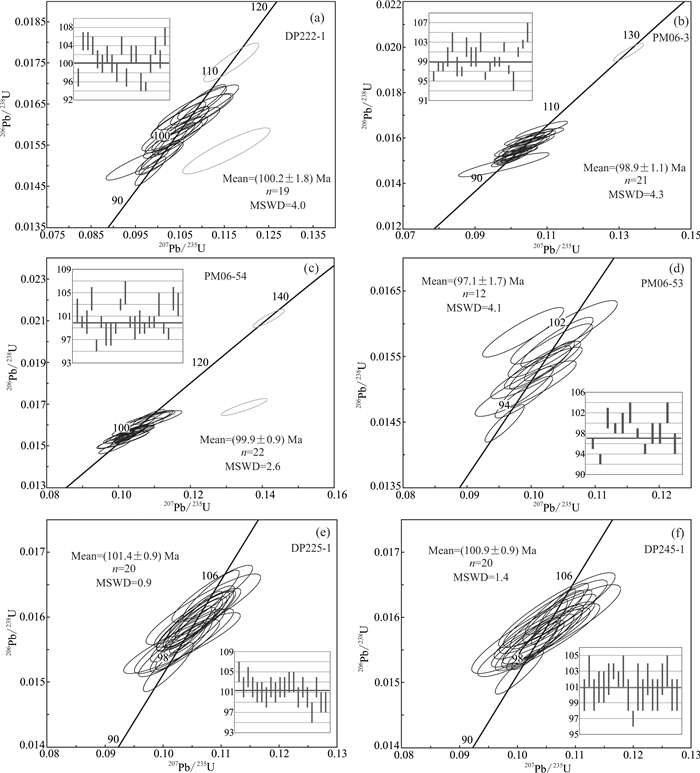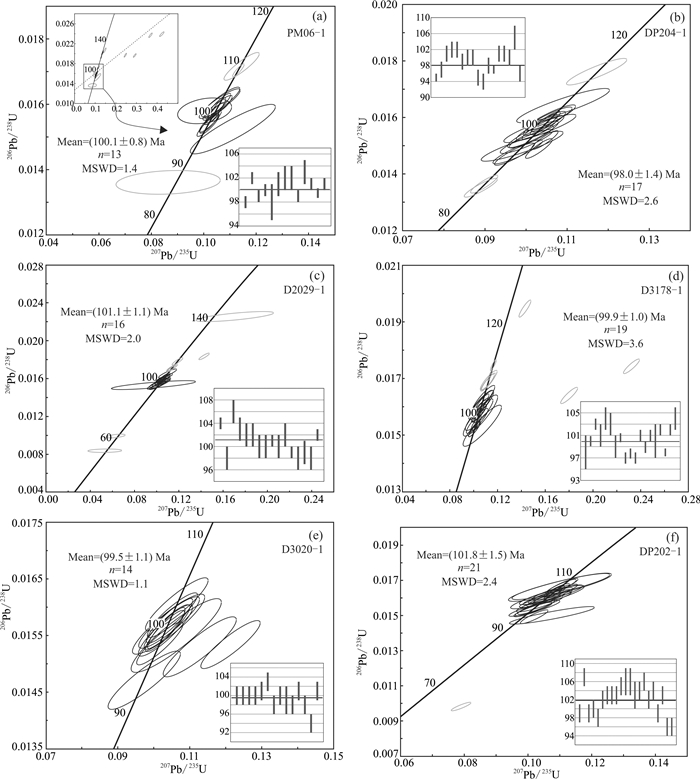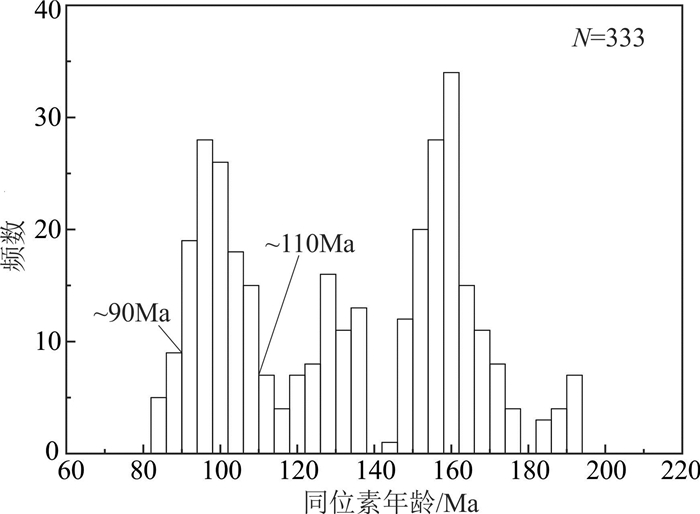Zircon LA-ICP-MS U-Pb dating of granites in Qiashui area, Guangdong Province: Constraints on the ~100 Ma tectonic setting of interior of South China
-
摘要:研究目的
东南沿海地区发育大量~100Ma的岩浆岩,在华南内陆该期岩浆作用虽报道较少但往往与成矿有关。查明该期岩浆作用在华南内陆的分布,将为该区晚燕山期构造背景的研究及相关找矿勘查提供科学依据。
研究方法基于1︰5万区域地质调查和详细的岩相学研究,对位于华南内陆的郴州—临武断裂附近的洽水地区花岗岩,划分为5个侵入次:(1)粗—中粒斑状含角闪石黑云母二长花岗岩;(2)中—细粒斑状含角闪石黑云母二长花岗岩;(3)中—细粒斑状黑云母二长花岗岩;(4)中—细粒含斑黑云母二长花岗岩;(5)细粒含斑黑云母正长花岗岩。然后系统地对不同侵入次的代表性岩石进行锆石LA-ICP-MS U-Pb定年。
研究结果获得第一到第五侵入次的年龄为102~97Ma,均属早—晚白垩世之交(~100Ma)侵入岩。
结论综合分析对比华南内陆及东南沿海地区~100Ma的岩浆事件,认为华南内陆该期岩浆活动的动力学机制是:古太平洋板块俯冲后撤引发的弧后及陆内岩石圈伸展,导致郴州—临武等古深大断裂重新活化拉张,引起软流圈上涌和岩石圈减薄,进而产生较强烈的幔源和壳源岩浆活动。
创新点:提出华南内陆~100 Ma的岩浆活动与古太平洋板块俯冲后撤引发陆内岩石圈伸展,导致郴州—临武等 古深大断裂活化有关。
Abstract:This paper is the result of geological survey engineering.
ObjectiveA large amount of ~ 100 Ma magmatic rocks are developed in the southeast margin of South China. Shifting to interior of South China, although the period of magmatism has been reported sparingly, they were often related to metal mineralization. Determination of the distribution of magmatism of ~ 100 Ma in the interior of South China would provide a scientific basis for the study of the late Yanshanian tectonic setting, and related ore prospecting and exploration.
MethodsBased on the 1︰50000 regional geological survey and detailed petrographic study, the granites in Qiashui area, which are located near the Chenzhou-Linwu fault in the interior of South China, were divided into five intrusive episodes, including (1) porphyritic coarse-medium-grained amphibole-biotite monzogranite, (2) porphyritic medium-fine-grained amphibole-bearing biotite monzogranite, (3) porphyritic medium-fine-grained biotite monzogranite, (4) medium-fine-grained biotite monzogranite with rare porphyrites and (5) fine-grained biotite syenogranite with rare porphyrites, respectively. Zircon LA-ICP-MS U-Pb dating was carried out systematically for the representative rocks of these intrusions.
ResultsU-Pb dating yield ages of the first to fifth intrusive episodes ranges from 102 Ma to 97 Ma, which is at the transition of the Early and Late Cretaceous.
ConclusionsAccording to comprehensive analysis and comparison of the ~100 Ma magmatic events in the interior and southeast coastal regions of South China, it shows that the geodynamic mechanism of the magmatism of ~100 Ma in the interior of South China might be related to back arc and intracontinental lithospheric extension resulting from Paleo-Pacific plate subduction retreation. It led to reactivation and extension of ancient deep faults such as the Chenzhou Linwu fault, and then the intensive mantle and crust magmatism.
-
1. 引言
华南广泛发育的中生代岩浆岩(图 1a)长期受到地质学家的关注(Jahn, 1974; Zhou et al., 2000; 王强等, 2005; 孙涛, 2006; 周新民, 2007; Li and Li, 2007; 杨明桂等, 2009; 徐先兵等, 2009; 舒良树, 2012; Wang et al., 2013; 郑永飞等, 2013; 崔建军等, 2013; 李三忠等, 2018;苑新晨等,2021)。尤其对华南晚中生代花岗岩类进行了较深入的研究,对其时空分布格局、岩石成因、形成构造背景及与成矿关系等方面取得了一系列的进展(Zhou and Li, 2000; 王强等, 2005; 孙涛, 2006; 周新民, 2007; 付建明等, 2007; 柏道远等, 2008; 肖庆辉等, 2010; 舒良树, 2012; 阳杰华等, 2017; 贾丽辉, 2018; Chen et al., 2019; 袁永盛等,2020;李宏卫等,2021)。其中,发现100 Ma左右的岩浆岩在东南沿海地区大量发育(王德滋和沈渭洲, 2003; 肖娥等, 2007; 李良林等, 2013; Chen et al., 2014; Zhao et al., 2016; Yan et al., 2016; 贾丽辉, 2018),而华南腹地(特别是南岭地区)该时期的岩浆活动较少(王强等, 2005; 蔡明海等, 2006; 贾小辉等, 2014; Wang et al., 2018)。对其成因及形成的构造环境仍存在争议,提出了如活动大陆边缘构造-岩浆作用(Jahn, 1974; Zhou et al., 2006)、大陆伸展-裂解(Gilder et al., 1991)、阿尔卑斯型碰撞造山(Hsu et al., 1990)等不同的认识。
![]() 图 1 华南主要构造单元和中生代岩浆岩分布图(a, 据Zhou and Li, 2000; Wang et al., 2013修改)、连阳岩体地质简图(b, 据高剑峰等, 2005修改;同位素年龄数据马星华等, 2014)及研究区地质简图与采样位置图(c, 据袁永盛等, 2020修改)1—燕山期火山岩;2—燕山期侵入岩;3—印支期侵入岩;4—大地构造单元界线;5—深大断裂;6—晚白垩世花岗斑岩;7—晚白垩世第五侵入次花岗岩;8—晚白垩世第四侵入次二长花岗岩;9—晚白垩世第三侵入次二长花岗岩;10—晚白垩世第二侵入次二长花岗岩;11—晚白垩世第一侵入次二长花岗岩;12—早白垩世正长花岗岩;13—地质界线;14—断层;15—采样位置;Q—第四系;K—白垩系;J—侏罗系;T—三叠系;C—石炭系;Є—寒武系;Є-K—寒武系—白垩系Figure 1. Geological sketch map of main tectonic units and Mesozoic igneous rocks in South China (a, modified from Zhou and Li, 2000; Wang et al., 2013), geological sketch of the Lianyang pluton (b, modified from Gao Jianfeng et al., 2005; isotopic age from Ma Xinhua et al., 2014), geological sketch and sampling location of the investigated area (c, modified from Yuan Yongsheng et al., 2020)1-Yanshanian volcanics; 2-Yanshanian intrusives; 3-Indosinian intrusives; 4-Boundary between tectonic block; 5-Deep fault; 6-Late Cretaceous granite porphyry; 7-The fifth intrusive episodes granite in Late Cretaceous; 8-The fourth intrusive episodes monzogranite of Late Cretaceous; 9-The third intrusive episodes monzogranite in Late Cretaceous; 10-The second intrusive episodes monzogranite in Late Cretaceous; 11-The first in-trusive episodes monzogranite in Late Cretaceous; 12-Early Cretaceous syenogranite; 13-Geological boundary; 14-Fault; 15-Sampling location; Q-Quaternary; K-Cretaceous; J-Jurassic; T-Triassic; C-Carboniferous; Є-Cambrian; Є-K-Cambrian-Cretaceous
图 1 华南主要构造单元和中生代岩浆岩分布图(a, 据Zhou and Li, 2000; Wang et al., 2013修改)、连阳岩体地质简图(b, 据高剑峰等, 2005修改;同位素年龄数据马星华等, 2014)及研究区地质简图与采样位置图(c, 据袁永盛等, 2020修改)1—燕山期火山岩;2—燕山期侵入岩;3—印支期侵入岩;4—大地构造单元界线;5—深大断裂;6—晚白垩世花岗斑岩;7—晚白垩世第五侵入次花岗岩;8—晚白垩世第四侵入次二长花岗岩;9—晚白垩世第三侵入次二长花岗岩;10—晚白垩世第二侵入次二长花岗岩;11—晚白垩世第一侵入次二长花岗岩;12—早白垩世正长花岗岩;13—地质界线;14—断层;15—采样位置;Q—第四系;K—白垩系;J—侏罗系;T—三叠系;C—石炭系;Є—寒武系;Є-K—寒武系—白垩系Figure 1. Geological sketch map of main tectonic units and Mesozoic igneous rocks in South China (a, modified from Zhou and Li, 2000; Wang et al., 2013), geological sketch of the Lianyang pluton (b, modified from Gao Jianfeng et al., 2005; isotopic age from Ma Xinhua et al., 2014), geological sketch and sampling location of the investigated area (c, modified from Yuan Yongsheng et al., 2020)1-Yanshanian volcanics; 2-Yanshanian intrusives; 3-Indosinian intrusives; 4-Boundary between tectonic block; 5-Deep fault; 6-Late Cretaceous granite porphyry; 7-The fifth intrusive episodes granite in Late Cretaceous; 8-The fourth intrusive episodes monzogranite of Late Cretaceous; 9-The third intrusive episodes monzogranite in Late Cretaceous; 10-The second intrusive episodes monzogranite in Late Cretaceous; 11-The first in-trusive episodes monzogranite in Late Cretaceous; 12-Early Cretaceous syenogranite; 13-Geological boundary; 14-Fault; 15-Sampling location; Q-Quaternary; K-Cretaceous; J-Jurassic; T-Triassic; C-Carboniferous; Є-Cambrian; Є-K-Cambrian-Cretaceous位于南岭西段的连阳花岗岩体曾被认为是复式侵入体,主要由晚侏罗世产出的粗—中粒花岗岩主体和早白垩世晚期侵位的中—细粒花岗岩补体构成(高剑峰等, 2005; 马星华等, 2014; 袁永盛等, 2020)。连阳岩体虽然位于南岭成矿带南部,但此前因为与其相关的矿产发现较少,所以对其研究在过去未得到足够重视。随着近年的矿产勘查与1∶5万地质调查工作的开展,在岩体与围岩接触带附近新发现了多处矽卡岩型磁铁矿、铁多金属矿以及矽卡岩型-热液脉型多金属矿床等。李晶等(2010)曾对连阳岩体北侧姓坪矽卡岩型钼多金属矿进行辉钼矿Re-Os法定年,获得其模式年龄范围为99.7~ 92.1 Ma,等时线年龄为97.9 Ma,与连阳花岗岩体侵位年龄相一致,表明成矿与岩体的形成密切相关。
由于此前位于洽水地区的连阳岩体南部及南侧的白水寨、鸡笼岭、将军头等花岗岩体缺乏精确的年代学资料,曾被认为均是晚侏罗世岩浆活动的产物(高剑峰等, 2005; 广西壮族自治区地质调查院,2005❶)。笔者近年来在粤西北洽水地区开展了1∶5万区域地质调查,在详细的野外地质调查及岩相学工作的基础上,对岩体进行侵入期次划分,并通过系统的LA-ICP-MS锆石U-Pb法精确测年,厘定上述岩体为100 Ma左右岩浆活动的产物。结合前人对华南同期(110~90 Ma)岩浆岩类的研究成果,进一步探讨连阳及其南侧一些花岗岩体的成因和华南晚中生代岩石圈伸展过程的地球动力学机制。
2. 区域地质背景及岩体地质概况
华南陆块紧邻太平洋板块西缘,由华夏地块和扬子地块于新元古代沿NE向的江—绍断裂带(大致与十—杭带重合)发生碰撞-拼贴形成(图 1a),并在显生宙主要经历了早古生代、早中生代和晚中生代3期强烈的构造-岩浆活动的改造(Wang et al., 2012)。自中侏罗世开始,华南陆块逐渐转变成以伸展为主的构造环境,岩浆事件频繁。晚侏罗世—早白垩世形成了大规模呈NE—NNE向展布的穹隆构造和断陷火山-沉积盆地,并发育大量流纹质岩石、I型、A型花岗岩和少量玄武质岩石等火山-侵入岩类,岩浆岩以广泛分布的钙碱性岩石为主,并呈现出向洋年轻化的分布规律(王德滋和沈渭洲, 2003; Zhou et al., 2006; 周新民, 2007; Chen et al., 2008)。晚白垩世岩浆活动主要分布在浙闽粤沿海区域,受余姚—丽水—政和—大埔断裂、温州—镇海断裂及长乐—南澳断裂所控制,以I型、A型花岗岩、流纹质-玄武质岩石等双峰式火山岩为主,呈NE向分布(Chen et al., 2008; Zhao et al., 2015)。
连阳岩体地处粤西北,位于郴州—临武大断裂东侧、华夏地块西部的南岭纬向构造-岩浆岩带南带(花山—连阳—佛冈—新丰江岩带)的西段,出露面积约1600 km2,为一大型花岗质岩基(高剑峰等, 2005; 马星华等, 2014; 袁永盛等, 2020),与加里东期大宁岩体和广宁岩体在空间上密切共生(图 1b)。本文报道的洽水地区花岗岩体,包括连阳岩基南部及其南侧的白水寨、鸡笼岭、将军头等岩株,以100 Ma左右的岩浆活动为主,可划分为5个侵入次(图 1c,详见后述)。另见很少量114 Ma的细粒少斑黑云母正长花岗岩(ζγK1)(另文发表)。区内地层主要为寒武系、石炭系、三叠系、侏罗系及白垩系,除寒武系岩性以变质砂岩、板岩等变质岩为主外,其他地层岩性主要为灰岩、白云质灰岩、砾岩、砂岩、粉砂岩、泥岩等。岩体主要受近SN向及NE—NNE向断裂控制。围岩与岩体接触带附近发生一定程度的角岩化、矽卡岩化、大理岩化等接触变质或接触交代变质作用,并新发现了多处矽卡岩型磁铁矿、铁多金属矿以及矽卡岩型-热液脉型多金属矿床等。
3. 岩石学特征
依据岩性\特征的不同及野外穿切关系,洽水地区(连阳岩体南部及南侧的白水寨、鸡笼岭、将军头小岩体)约100 Ma花岗岩体从早到晚可分为5个侵入次(图 1c),分别为第一侵入次粗—中粒斑状含角闪石黑云母二长花岗岩(ηγK21)、第二侵入次中—细粒斑状含角闪石黑云母二长花岗岩(ηγK22)、第三侵入次中—细粒斑状黑云母二长花岗岩(ηγK23)、第四侵入次中—细粒含斑黑云母二长花岗岩(ηγK24)和第五侵入次细粒含斑黑云母正长花岗岩(γK25)。各侵入次之间均具有较为明显的接触界线,并呈侵入接触关系(图 2a、b)。
![]() 图 2 洽水地区第一和第四侵入次、第四和第五侵入次花岗岩的接触特征a—第四侵入次花岗岩(左)侵入到第一侵入次花岗岩中;b—第五侵入次花岗岩侵入到第四侵入次花岗岩中Figure 2. Contacts between the first and fourth, and the fourth and fifth intrusive episodes granites in Qiashui regiona-The fourth episode(left) intruded into the first intrusive episode granite; b-The fifth episode intruded into the fourth intrusive episode granite
图 2 洽水地区第一和第四侵入次、第四和第五侵入次花岗岩的接触特征a—第四侵入次花岗岩(左)侵入到第一侵入次花岗岩中;b—第五侵入次花岗岩侵入到第四侵入次花岗岩中Figure 2. Contacts between the first and fourth, and the fourth and fifth intrusive episodes granites in Qiashui regiona-The fourth episode(left) intruded into the first intrusive episode granite; b-The fifth episode intruded into the fourth intrusive episode granite第一侵入次粗—中粒斑状含角闪石黑云母二长花岗岩(ηγK21):块状构造,似斑状结构(图 3a、b)。主要由钾长石斑晶(7% ~25%)和基质钾长石(20% ~ 26%)、斜长石(26%~35%)、石英(25%~28%)、黑云母(4%~8%)及角闪石(0.5%~2%)等组成。副矿物主要有磁铁矿、褐帘石、钛铁矿、榍石、锆石、磷灰石和绿帘石,含少量黄铁矿和萤石。钾长石斑晶粒径8~40 mm,以半自形—他形为主,具条纹结构,常见有斜长石、黑云母、石英等包裹体,部分边缘可见有浅色斜长石围绕形成的“环斑”结构。基质主要为粗—中粒花岗结构,粒径2~6 mm为主,斜长石半自形板柱状,少量见环带结构,据电子探针分析结果(附表略,下同),其斜长石牌号An值为19.6~32.7;黑云母,鳞片状为主,局部丛状,据电子探针分析结果(附表略,下同),MF值0.30~0.39,属铁质黑云母(图 4a);角闪石,半自形长柱状,据电子探针分析结果(附表略,下同),按Leake et al.(1997)的分类方案,属铁角闪石(图 4b)。该次侵入岩中常见有浑圆状、椭圆状、不规则状暗色微粒包体(MME),大小一般为1 cm×2 cm~ 12 cm×15 cm,与主岩界线多较截然,个别为渐变,部分可见暗色矿物团粒(双包体)及长石、石英混染“斑晶”,其中有的石英“斑”具有眼斑结构(图 3a),即石英“斑”遭受熔蚀并与岩浆反应生成角闪石、黑云母等暗色矿物环边。MME的基质为微细粒结构,粒径一般为0.01~0.5 mm,矿物组成:角闪石约25%,黑云母约20%,斜长石约52%,副矿物主要有磁铁矿、榍石、磷灰石。斜长石常为自形长板条状,磷灰石常为针状。
![]() 图 3 洽水地区第一、第二和第三侵入次花岗岩野外与显微照片第一侵入次花岗岩(含MME)露头(a)及镜下特征(b);第二侵入次花岗岩露头(c)及镜下特征(d);第三侵入次花岗岩露头(e)及镜下特征(f);Q—石英;Kfs—钾长石;Pl—斜长石;Bt—黑云母;MME—暗色微粒包体Figure 3. Field and microscope photos of the first, second and third intrusive episodes granites in Qiashui regionOutcrop (a) and microscopic characteristics (b) of the first intrusive episode (MME-bearing); Outcrop (c) and microscopic characteristics (d) of the second intrusive episode; Outcrop (e) and microscopic characteristics (f) of the third intrusive episode; Q-Quartz; Kfs-K-feldspar; Pl-Plagioclase; Bt-Biotite; MME-Mafic magmatic enclave
图 3 洽水地区第一、第二和第三侵入次花岗岩野外与显微照片第一侵入次花岗岩(含MME)露头(a)及镜下特征(b);第二侵入次花岗岩露头(c)及镜下特征(d);第三侵入次花岗岩露头(e)及镜下特征(f);Q—石英;Kfs—钾长石;Pl—斜长石;Bt—黑云母;MME—暗色微粒包体Figure 3. Field and microscope photos of the first, second and third intrusive episodes granites in Qiashui regionOutcrop (a) and microscopic characteristics (b) of the first intrusive episode (MME-bearing); Outcrop (c) and microscopic characteristics (d) of the second intrusive episode; Outcrop (e) and microscopic characteristics (f) of the third intrusive episode; Q-Quartz; Kfs-K-feldspar; Pl-Plagioclase; Bt-Biotite; MME-Mafic magmatic enclave![]() Figure 4. Composition classification diagrams for biotite (a, after Foster, 1960) and amphibole (b, after Leake et al., 1997) from the granites in Qiashui area
Figure 4. Composition classification diagrams for biotite (a, after Foster, 1960) and amphibole (b, after Leake et al., 1997) from the granites in Qiashui area第二侵入次中—细粒斑状含角闪石黑云母二长花岗岩(ηγK22):块状构造,似斑状结构(图 3c、d)。斑晶粒径多在6~40 mm,以钾长石(10%~20%)为主,常见斜长石、黑云母、石英等包裹体,部分边缘可见有浅色斜长石围绕形成的“环斑”结构,偶见角闪石斑晶,局部见少量石英、斜长石斑晶。基质为中—细粒花岗结构,主要由粒径0.3~4 mm的钾长石(20% ~25%)、斜长石(25% ~33%)、石英(25% ~ 29%)、黑云母(5%~6%)和角闪石(1%~2%)等组成,副矿物主要有磁铁矿、褐帘石、钛铁矿、榍石和锆石,含少量黄铁矿、磷灰石及绿帘石。斜长石,半自形板柱状,少量见环带结构,An值绝大多数为15~ 27.9,个别35.5;黑云母,鳞片状—丛状,MF值0.24~0.38, 属铁质黑云母;角闪石,半自形长柱状,属铁角闪石。该次侵入岩中也常见浑圆状、椭圆状、不规则状暗色微粒包体(MME),与第一侵入次中的MME特点类似。
第三侵入次中—细粒斑状黑云母二长花岗岩(ηγK23):块状构造,似斑状结构(图 3e、f)。主要由粒径8~30 mm的钾长石斑晶(7%~15%)和粒径0.3~4 mm的钾长石(20%~25%)、斜长石(23%~33%)、石英(28%~32%)和黑云母(4%~6%)等基质组成。钾长石斑晶部分边缘可见有浅色斜长石围绕形成的“环斑”结构,常见有斜长石、黑云母、石英等包裹体。钾长石,具条纹结构,半自形板柱状—他形粒状;斜长石,半自形板柱状,少量见环带结构,An值为15.1~29.9;黑云母,鳞片状—丛状,MF值0.24~ 0.37, 属铁质黑云母。副矿物主要有磁铁矿、褐帘石、榍石、锆石、钛铁矿和磷灰石,含少量萤石和绿帘石。该次侵入岩见少量MME,特点与第一侵入次中的类似。
第四侵入次中—细粒含斑黑云母二长花岗岩((ηγK24):块状构造,似斑状结构(图 5a、b)。主要由粒径6~18 mm的钾长石斑晶(1% ~5%)和粒径0.3~3.5 mm的钾长石(35%~42%)、斜长石(21% ~ 29%)、石英(29%~33%)和黑云母(4%~5%)等基质组成。副矿物主要有磁铁矿、钛铁矿、独居石、褐帘石、锆石和绿帘石,含少量黄铁矿、榍石及磷灰石。钾长石斑晶中见有斜长石、黑云母、石英等包裹体。基质为中—细粒花岗结构,钾长石,具条纹结构,半自形板柱状—他形粒状,常高岭土化;斜长石,半自形板柱状,少量见环带结构,An值多为10.2~24.7,个别28~36.2,常绢云母化、黝帘石化;黑云母,鳞片状—丛状,MF值一般0.20~0.35,多属铁质黑云母,少部分属铁黑云母。靠近MME的主岩中个别黑云母MF值达0.53~0.74,可能是从MME中混染的黑云母。该次侵入岩局部可见少量MME。
![]() 图 5 洽水地区第四、第五侵入次花岗岩野外与显微照片第四侵入次花岗岩露头(a)及镜下特征(b);第五侵入次花岗岩露头(c)及镜下特征(d);Q—石英;Kfs—钾长石;Pl—斜长石;Bt—黑云母Figure 5. Field and microscope photos of the fourth and fifth intrusive episodes granites in Qiashui regionOutcrop (a) and microscopic characteristics (b) of the fourth intrusive episode; Outcrop (c) and microscopic characteristics (d) of the fifth intrusive episode; Q-Quartz; Kfs-K-Feldspar; Pl-Plagioclase; Bt-Biotite
图 5 洽水地区第四、第五侵入次花岗岩野外与显微照片第四侵入次花岗岩露头(a)及镜下特征(b);第五侵入次花岗岩露头(c)及镜下特征(d);Q—石英;Kfs—钾长石;Pl—斜长石;Bt—黑云母Figure 5. Field and microscope photos of the fourth and fifth intrusive episodes granites in Qiashui regionOutcrop (a) and microscopic characteristics (b) of the fourth intrusive episode; Outcrop (c) and microscopic characteristics (d) of the fifth intrusive episode; Q-Quartz; Kfs-K-Feldspar; Pl-Plagioclase; Bt-Biotite第五侵入次细粒含斑黑云母正长花岗岩(γK23):块状构造,似斑状结构(图 5c、d)。斑晶粒径多在2~ 13 mm,以钾长石(1%~3%)为主,少量石英、斜长石斑晶,偶见黑云母斑晶,斑晶钾长石中可见细小斜长石、黑云母、石英等包裹体。基质主要为细粒花岗结构,常见显微文像结构,主要由粒径0.2~1.5 mm的钾长石(39%~45%)、斜长石(14%~21%)、石英(30%~34%)和黑云母(2%~5%)等组成。副矿物主要有磁铁矿、钛铁矿、黄铁矿、独居石和锆石,含少量萤石、磷灰石。钾长石,具条纹结构,半自形板柱状—他形粒状,常泥化;斜长石,半自形板柱状,少量见环带结构,An值1.0~27.8,且多低于17,常绢云母化;黑云母,鳞片状—丛状,MF值绝大多数0.13~0.21,个别0.28,绝大多数属铁黑云母。
5个侵入次岩石的岩性特征表明,洽水地区(连阳岩体南部和南侧小岩体)花岗岩从早期侵入次到晚期侵入次,矿物颗粒粒度、暗色矿物含量总体逐渐降低,表现为黑云母含量逐渐下降,其MF值逐渐降低,从铁质黑云母变为铁黑云母。角闪石从有到无,斜长石牌号(An值)逐渐降低。岩石副矿物含量变化较大,其中早期侵入体的副矿物含量较高,晚期副矿物含量逐渐减少,主要表现为磁铁矿、榍石含量随岩浆演化不断降低,但钛铁矿和独居石有所增加,晚期还常出现萤石,总体副矿物组合为典型的磁铁矿-钛铁矿-榍石-锆石组合系列。第一和第二侵入次岩石中常见有MME,第三和第四侵入次岩石中含少量MME。MME多呈椭圆状或浑圆状,具有石英“眼斑”结构及斜长石自形长板条结构、磷灰石针状结构等岩相学特征,表明其为幔源岩浆与壳源岩浆(主岩)发生混合的产物(Xie et al., 2020)。第一至第三侵入次的主岩中常见钾长石斑晶的“环斑”结构(幔状长石结构),也反映了壳-幔岩浆混合作用(Narayana et al., 2000; 王超等, 2008)。综合分析表明,洽水地区壳源花岗质岩浆经历了较明显的分离结晶作用和一定程度的壳幔岩浆混合作用(袁永盛等, 2020)。
4. 采样位置与测试方法
本次工作在洽水地区的连阳岩体南部及其南侧的白水寨、鸡笼岭、将军头花岗岩体共采集了12件新鲜的锆石U-Pb年代学样品。其中DP222-1、PM06-3采自第一侵入次粗—中粒斑状含角闪石黑云母二长花岗岩,PM06-54采自第二侵入次中—细粒斑状含角闪石黑云母二长花岗岩,PM06-53、DP225-1和DP245-1采自第三侵入次中—细粒斑状黑云母二长花岗岩,PM06-1、DP204-1、D2029-1、D3178-1和D3020-1采自第四侵入次中—细粒含斑黑云母二长花岗岩,DP202-1采自第五侵入次细粒含斑黑云母正长花岗岩(图 1c)。
野外在岩体新鲜未蚀变位置采集样品5 kg,采用人工重砂法分选出锆石。锆石颗粒用环氧树脂固定并抛光露出核部(宋彪等, 2002),然后进行透射光和反射光照相,并使用JXA 8100型电子探针进行阴极发光(CL)照相(图 6)。锆石LA-ICP-MS U-Pb定年工作在南京大学内生金属矿床成矿机制研究国家重点实验室完成,使用Agilent 7500a ICP-MS连接起来的New Wave 213 nm激光剥蚀系统完成。分析过程中,激光束斑直径32 μm,频率5 Hz。U-Pb分馏采用澳大利亚锆石标样GEMOC GJ-1 (207Pb/206Pb年龄为(608.5 ± 1.5)Ma, Jackson et al., 2004) 进行校正,以Mud Tank((732 ± 5)Ma, Black and Gulson, 1978)作为内标控制分析精度。U-Pb年龄计算由GLITTER软件(4.4) 在线获得。使用ComPbCorr#3-15G程序(Andersen, 2002)进行普通铅校正。年龄数据处理采用ICPMS Data Cal(8.9)(Liu et al., 2008)和Isoplot(3.0)(Ludwig, 2003)软件进行。详细测试方法和流程见Griffin et al.(2004)。
5. 分析结果
12件样品中锆石以无色或浅黄色、黄粉色、褐粉色为主,透明—半透明,金刚光泽,多呈自形—半自形双锥柱状、柱状,晶内裂纹较发育,部分可见黑色包体,柱面以(110)占绝对优势,表明锆石形成温度较高。在阴极发光(CL)图像上(图 6),大部分锆石具有典型酸性岩浆锆石的振荡环带,且Th/U比值较高(为0.1~3.9,平均值为0.9,表 1),均显著>0.1,表明锆石为岩浆成因(周剑雄和陈振宇, 2007)。锆石LA-ICP-MS U-Pb定年结果分别如下所述:
表 1 洽水地区第一至第五次花岗岩锆石 LA-ICP-MS U-Pb 测年结果Table 1. Zircon LA-ICP-MS U-Pb data of the first to fifth episodes granites in Qiashui region
第一侵入次:样品DP222-1共分析了21个测点,结果见表 1和图 7a。其中19个测点的206Pb/238U年龄集中在106~95 Ma,且全落在U-Pb年龄谐和线上或附近,计算其加权平均年龄为(100.2±1.8)Ma(n=19,MSWD=4.0)。16号点明显偏离谐和线,15号点给出了112 Ma的谐和206Pb/238U表面年龄,且该点的CL图像具有典型岩浆锆石振荡环带,为捕获锆石,因此上述测点在计算年龄时未统计在内。样品PM06-3共分析了22个测点,结果见表 1和图 7b。其中21个测点的206Pb/238U年龄集中在105~95 Ma,且全落在U-Pb年龄谐和线上或附近,计算其加权平均年龄为(98.9 ± 1.1)Ma(n=21,MSWD= 4.3)。10号点给出了126 Ma的谐和206Pb/238U表面年龄,且该点的CL图像具有典型岩浆锆石振荡环带,为捕获锆石,计算年龄时未统计在内。
第二侵入次:样品PM06-54共分析了24个测点,结果见表 1和图 7c。其中22个测点的206Pb/238U年龄集中在105~96 Ma,且全落在U-Pb年龄谐和线上或附近,计算其加权平均年龄为(99.9±0.9)Ma(n= 22,MSWD=2.6)。8号点明显偏离谐和线,14号点为捕获锆石(135 Ma),计算年龄时未统计在内。
第三侵入次:样品PM06-53共分析了12个测点,结果见表 1和图 7d。所有测点的206Pb/238U年龄集中在102~93 Ma,且全落在U-Pb年龄谐和线上或附近,计算其加权平均年龄为(97.1 ± 1.7)Ma(n=12,MSWD=4.1)。样品DP225-1共分析了20个测点,结果见表 1和图 7e。所有测点的206Pb/238U年龄集中在105~97 Ma,且全落在U-Pb年龄谐和线上或附近,计算其加权平均年龄为(101.4±0.9)Ma(n=20,MSWD= 0.9)。样品DP245-1共分析了20个测点,结果见表 1和图 7f。所有测点的206Pb/238U年龄集中在103~97 Ma,且全落在U-Pb年龄谐和线上或附近,计算其加权平均年龄为(100.9±0.9)Ma(n=20,MSWD=1.4)。
第四侵入次:样品PM06-1共分析了25个测点,结果见表 1和图 8a。其中13个测点的206Pb/238U年龄集中在103~98 Ma,且全落在U-Pb年龄谐和线上或附近,计算其加权平均年龄为(100.1±0.8)Ma(n=13,MSWD=1.4)。9、13、16和18号点明显均偏离谐和线;11号点给出了87 Ma的谐和206Pb/238U表面年龄,且该点的CL图像具有典型岩浆锆石振荡环带,表明可能为另一期岩浆活动产物;1、2、7、10、12、22和23号点均位于锆石核部,为捕获锆石(132~109 Ma),因此上述测点在计算年龄时未统计在内。样品DP204-1共分析了20个测点,结果见表 1和图 8b。其中17个测点的206Pb/238U年龄集中在105~94 Ma,且全落在U-Pb年龄谐和线上或附近,计算其加权平均年龄为(98.0 ± 1.4)Ma(n=17,MSWD=2.6)。20号点给出了113 Ma的谐和206Pb/238U表面年龄,可能为捕获锆石;12、15号点给出了87 Ma的表面年龄,且该点的CL图像具有典型岩浆锆石振荡环带,表明可能为另一期岩浆活动产物,因此上述测点在计算年龄时未统计在内。样品D2029-1共分析了24个测点,结果见表 1和图 8c。其中16个测点的206Pb/238U年龄集中在106~98 Ma,且全落在U-Pb年龄谐和线上或附近,计算其加权平均年龄为(101.1 ± 1.1)Ma(n=16,MSWD= 2.0)。14号点明显偏离谐和线,5、7、20、22和23号点为捕获锆石(144~109 Ma),13、17号点给出了63.8 Ma、53.9 Ma的谐和表面年龄,可能为另一期岩浆细脉混入。因此上述测点在计算年龄时未统计在内。样品D3178-1共分析了27个测点,结果见表 1和图 8d。其中19个测点的206Pb/238U年龄集中在104~97 Ma,且全落在U-Pb年龄谐和线上或附近,计算其加权平均年龄为(99.9 ± 1.0)Ma(n=19,MSWD=3.6)。7、15和24号点明显偏离谐和线,4、5、14、21和22号点可能为捕获锆石(112~108 Ma),因此上述测点在计算年龄时未统计在内。样品D3020-1共分析了14个测点,结果见表 1和图 8e。所有测点的206Pb/238U年龄集中在103~94 Ma,且全落在U-Pb年龄谐和线上或附近,计算其加权平均年龄为(99.5±1.1)Ma(n=14,MSWD=1.1)。
第五侵入次:样品DP202-1共分析了22个测点,结果见表 1和图 8f。其中21个测点的206Pb/238U年龄集中在107~96 Ma,且全落在U-Pb年龄谐和线上或附近,计算其加权平均年龄为(101.8±1.5)Ma(n=21,MSWD=2.4)。22号点获得明显偏年轻的206Pb/238U表面年龄(63±1)Ma,可能为另一期岩浆细脉混入。
总体而言,12件样品的有效测点数据均落在U-Pb年龄谐和线上或附近,具有非常一致的206Pb/238U年龄,总体集中在107~93 Ma,其加权平均年龄变化于(101.8±1.5)~(97.1±1.7)Ma,在误差范围内基本一致。上述年龄可代表洽水地区(连阳岩体南部和南侧小岩体)第一到第五侵入次花岗岩体的结晶(侵位)时代。
6. 讨论
6.1 洽水地区花岗岩体的形成时代
对于洽水地区(连阳岩体南部及南侧白水寨、鸡笼岭、将军头小岩体)花岗岩体的形成时代,由于缺乏精确的同位素年龄,前人曾认为其均是晚侏罗世岩浆活动的产物(高剑峰等, 2005; 广西壮族自治区地质调查院, 2005❶)。前人曾获得连阳岩体黑云母K-Ar年龄为99~98 Ma和130~125 Ma(全国同位素地质年龄数据汇编第四集, 1986; 广东省地质矿产局, 1988),全岩Rb-Sr年龄为104~100 Ma(广西壮族自治区地质调查院, 2005❶)。由于上述方法获得的年龄有可能是受热事件改造的年龄,无法确凿地解释为连阳岩体的形成时代。近年来,利用更高精度及地质解释更明确的LA-ICP-MS锆石U-Pb法获得连阳岩体中北部中—细粒花岗岩同位素年龄为104~81 Ma(马星华等, 2014; 中国地质调查局武汉地质调查中心, 2015❷),连阳岩体南部粗—中粒斑状含角闪石黑云母二长花岗岩的同位素年龄为(99.4±0.7)Ma(袁永盛等, 2020)。本次采用LA-ICP-MS锆石U-Pb法获得洽水地区第一侵入次粗—中粒斑状含角闪石黑云母二长花岗岩、第二侵入次中—细粒斑状含角闪石黑云母二长花岗岩、第三侵入次中—细粒斑状黑云母二长花岗岩、第四侵入次中—细粒含斑黑云母二长花岗岩和第五侵入次细粒含斑黑云母正长花岗岩的成岩年龄分别为(100.2±1.8)~(98.9±1.1)Ma、(99.9±0.9)Ma、(101.4±0.9)~(97.1±1.7)Ma、(101.1±1.1)~(98.0±1.4)Ma和(101.8±1.5)Ma,年龄在误差范围内基本一致,代表连阳岩体南部及其南侧的白水寨、鸡笼岭、将军头花岗岩体的形成时代属早—晚白垩世之交(100 Ma±)。
值得一提的是,此次在洽水地区12件样品中获得了21颗捕获锆石,其年龄主要集中于114~108 Ma(n=13),剩余在144~123 Ma(n=8)(表 1,图 7,图 8),显示研究区曾存在过这些时代范围的岩浆活动。另外,作者还获得连阳岩体南部的寨坳细粒少斑黑云正长花岗质岩株的LA-ICP-MS锆石U-Pb年龄为(114.4±1.0)Ma(另文发表)。据此,结合本次获得的连阳岩体南部及南侧小岩体的同位素年龄综合分析,认为高剑峰等(2005)所报道的144 Ma的粗—中粒花岗岩可能仅为整个连阳岩基的局部产物,表明144 Ma左右的岩浆活动在洽水地区不是主要期次,连阳岩体应该主要于~100 Ma形成。
6.2 华南燕山晚期岩浆活动时空分布
综合已有资料,华南燕山期岩浆活动的时间可大致归纳为“两期3阶段”,分别是燕山早期(190~140 Ma)、燕山晚期第1阶段(140~120 Ma)和燕山晚期第2阶段(120~80 Ma)(图 9)。空间上,燕山早期花岗质岩浆活动主要分布于华南内陆地区,如闽西南、赣南、粤北及湘南等地,主体呈NE向分布,而在南岭地区为近EW向分布;燕山晚期的岩浆活动则广泛发育在长江中下游、浙闽沿海、琼南等一带,以NNE向展布(孙涛, 2006)。
![]() Figure 9. Histograms of isotopic ages for Yanshanian igneous rocks in South China (modified from Li et al., 2010; Jia Lihui, 2018)
Figure 9. Histograms of isotopic ages for Yanshanian igneous rocks in South China (modified from Li et al., 2010; Jia Lihui, 2018)近年来发表的一系列年代学成果(表 2)显示早—晚白垩世之交(110~90 Ma)是华南重要的构造-岩浆活动时期之一(图 9),该时期岩浆岩的空间分布与燕山晚期岩浆活动范围基本一致,集中分布于政和—大埔断裂以东的东南沿海地区,内陆则产出局限,且大部分岩体以岩株形式产出(图 10)。该时期东南沿海地区形成了大量中酸性岩浆岩(I型、A型花岗岩)及少量玄武质岩石(王德滋和沈渭洲,2003),如浙闽沿海地区的普陀山—大洞岙碱长花岗岩(98~96 Ma)(Zhao et al., 2016)、蜡江—东埔黑云母花岗岩(110.1~105.3 Ma)与石湖黑云母二长花岗岩((105.1±0.5)Ma)(丁聪, 2013),粤东三饶花岗闪长岩((102±1.9)Ma)、新圩花岗闪长岩(106~105 Ma)和石英闪长岩((103.5 ± 1.2)Ma)(贾丽辉, 2018),云开地区的天堂二长花岗斑岩((104.5±0.4)Ma)、石菉花岗闪长岩((103.7±0.5)Ma)和石英闪长岩(104.1~103.2 Ma)(郑伟, 2016)等I型花岗岩,大青山—桃花岛—虾峙岛过碱性花岗岩(89~86 Ma)(Zhao et al., 2016)、瑶坑碱性花岗岩((91.3 ± 2.5)Ma)(肖娥等, 2007)、太姥山—鼓山黑云母花岗岩(99.4~96.6 Ma)(李良林等, 2013)、石牛山正长花岗斑岩((93.8±1.3)Ma)(邢光福等, 2009)、洪山花岗岩(99 Ma)(黄泉祯, 1998)等A型花岗岩,以及少量主要受长乐—南澳断裂所控制的中基性脉岩、玄武质岩石,如福建永泰玄武岩(~85 Ma)(Meng et al., 2012)等。
表 2 华南 110~90 Ma 花岗岩类年代学资料Table 2. Geochronological data of the 110-90 Ma granitoids in South China
![]() 1—燕山期火山岩;2—燕山期侵入岩;3—燕山期玄武质岩石;4—代表性花岗岩体;5—代表性玄武岩体;6—地质块体边界;7—深大断裂;8—岩体名称及年龄/Ma(资料来源见表 2)Figure 10. Distribution of the 110-90 Ma granitoids and basaltic rocks in South China (modified from Zhou and Li, 2000; Wang et al., 2013)1-Yanshanian volcanics; 2-Yanshanian intrusives; 3-Yanshanian basaltic rocks; 4-Representative granitoid pluton; 5-Representative basaltic pluton; 6-Geological block boundary; 7-Deep fault; 8-Name and isotopic age /Ma of pluton (See Table 2 for data source)
1—燕山期火山岩;2—燕山期侵入岩;3—燕山期玄武质岩石;4—代表性花岗岩体;5—代表性玄武岩体;6—地质块体边界;7—深大断裂;8—岩体名称及年龄/Ma(资料来源见表 2)Figure 10. Distribution of the 110-90 Ma granitoids and basaltic rocks in South China (modified from Zhou and Li, 2000; Wang et al., 2013)1-Yanshanian volcanics; 2-Yanshanian intrusives; 3-Yanshanian basaltic rocks; 4-Representative granitoid pluton; 5-Representative basaltic pluton; 6-Geological block boundary; 7-Deep fault; 8-Name and isotopic age /Ma of pluton (See Table 2 for data source)而华南腹地该期岩浆活动范围较窄,主要以零星状态分布,除本文及前人报道的连阳花岗岩体((106.4±0.7)~(97.6±1.5)Ma)(高剑峰等, 2005; 马星华等, 2014; 袁永盛等,2020)外,尚有广西大厂黑云母花岗岩((93±1)Ma)和斑状花岗岩((91±1)Ma)(蔡明海等, 2006)、米场角闪黑云母花岗闪长岩(110~109 Ma)、三叉冲黑云母花岗岩((103 ± 1)Ma)、油麻坡花岗闪长岩((105±1)Ma)(Wang et al., 2018),湘南界牌岭花岗斑岩((92.0±1.6)Ma)(卢友月等, 2013),粤北新坪花岗闪长岩((104.6±1.8)Ma)(李宏卫等, 2021)、雪山嶂花岗斑岩((103.4±1.2)Ma)(贾小辉等, 2014)等。
综上所述,早—晚白垩世之交(110~90 Ma)发生了华南燕山晚期一次重要的构造-岩浆事件,广泛发育了碱性花岗岩、A型花岗岩、I型花岗岩、中基性脉岩、玄武质岩石等双峰式岩浆岩及一系列断陷拉张盆地等(Li, 2000; 杨振等, 2014)。
6.3 构造环境
关于华南燕山期花岗岩形成的大地构造背景及深部动力学机制已先后提出了如活动大陆边缘(Zhou and Li, 2000)、岩石圈伸展减薄与拆沉(张旗等, 2001)、板内伸展-裂谷环境(陈志刚等, 2003)、弧后环境(孙涛等, 2003)、平板俯冲(Li and Li, 2007)等不同模式。目前普遍认为,自燕山期以来华南腹地已经逐渐转变成以伸展拉张为主的构造环境,并经历了多期重要的伸展事件,古太平洋板块俯冲/后撤背景下幔源玄武质岩浆的底侵作用可能是导致华南晚中生代花岗质岩浆活动的重要原因(Zhou and Li, 2000; Zhou et al., 2006; Wang et al., 2012; Duan et al., 2017; 李三忠等, 2018)。
大地构造位置上,研究区位于郴州—临武深大断裂附近(图 10)(高剑峰等, 2005; 马星华等, 2014),该断裂被认为是华夏地块与扬子地块的岩石圈尺度缝合线(即十—杭带)(Gilder et al., 1996),是一个反复活化、深达软流圈的古构造薄弱带(Xie et al., 2020), 沿该断裂带分布有大量的燕山期幔源玄武质岩石(178~63 Ma),如湖南宁远—道县玄武岩(Li et al., 2004)、回龙圩煌斑岩(Wang et al., 2003)、长城岭斜斑玄武岩(Zhao et al., 1998; 杨帆等, 2018)、衡阳玄武岩和赣西北禾埠玄武岩(Meng et al., 2012)等,与同期花岗岩近于同时产出。华南内陆同期基性岩浆整体上具有更加亏损的Sr-Nd同位素组成,表现出从岛弧玄武岩向板内玄武岩逐步转变的趋势(杨帆等, 2018),暗示华南内陆在燕山期(特别是燕山晚期)可能经历了持续的伸展拉张作用,致使深部的软流圈幔源物质向上迁移。前人曾在华南识别出多条具低TDM-高εNd(t)值的燕山期花岗岩带,其中华夏地块TDM<1.7 Ga,εNd(t)>-7.0被认为是幔源物质参与岩浆演化过程的重要体现(Chen et al., 1998; 陈江峰等, 1999)。连阳花岗岩体具相对较高的εNd(t)值(-10.6~-4.2)、较年轻的二阶段Nd模式年龄(TDM2)(1.79~1.24 Ga)和较大变化范围的εHf(t)值(-10.5~+1.2)(高剑峰等, 2005; 马星华等, 2014; 袁永盛等, 2020; 作者未发表数据),在空间上正处于华南内陆的杭州—诸广山—花山低TDM-高εNd(t)值带附近(Chen and Jahn, 1998),这进一步明确了幔源岩浆不仅提供了源区岩石熔融所需的热,也一定程度为区内花岗岩提供了成岩物质。该结论与前述根据岩相学特征认为MME发生了幔源与壳源岩浆的混合作用的推论相一致。
相对于燕山晚期东南沿海发育大面积与俯冲相关的陆缘弧岩浆活动,同时期岩浆作用在华南内陆地区表现较为微弱(周新民, 2007)。燕山期华南内陆地区的构造-岩浆活动同东南沿海地区并不一致。笔者认为连阳岩体的形成并非直接起源于大洋板块或其上覆地幔楔,而可能与古太平洋板块不规则反复俯冲/后撤所导致的陆内或弧后剪切拉张环境相关,伴随该后撤作用发育大量的伸展构造活动(Li and Li, 2007; 郑永飞等, 2013),伸展活动影响华南内陆原先存在的郴州—临武等深大断裂,使其重新活化,软流圈地幔流沿这些薄弱带向上侵蚀上涌,导致岩石圈减薄,引起软流圈及上覆的富集岩石圈地幔发生部分熔融,形成幔源玄武质岩浆,并底侵华南中元古代陆壳基底岩石使其部分熔融形成花岗质岩浆,随后,花岗质岩浆可与玄武质岩浆发生岩浆混合。
7. 结论
(1)洽水地区(连阳岩体南部及南侧白水寨、鸡笼岭、将军头小岩体)花岗岩体的岩性主要为粒度不等的(角闪)黑云母二长花岗岩,少量黑云正长花岗岩,依据岩性特征及穿切关系的不同可划分为5个侵入次。
(2)通过锆石LA-ICP-MS U-Pb定年,新获得洽水地区第一到第五侵入次的年龄分别为102~ 97 Ma,均属燕山晚期早—晚白垩世之交(100 Ma±)的岩浆产物。认为连阳岩体主要于~100 Ma形成,144~123 Ma和~114 Ma的岩浆活动在洽水地区仅局部产出。
(3)综合分析表明,早—晚白垩世之交是华南一次重要的构造-岩浆活动时期。同期古太平洋板块向欧亚板块的俯冲/后撤所诱发的伸展作用,导致华南内陆的郴州—临武等古深大断裂重新活化,并引起软流圈上涌和岩石圈减薄,进而导致较强烈的幔源和壳源岩浆活动。连阳岩体的形成与此密切相关。
注释
❶广西壮族自治区地质调查院. 2005. 1∶250 000贺州市幅区域地质调查报告.
❷中国地质调查局武汉地质调查中心. 2015. 1∶50 000南乡、上程、福堂圩、小三江等4幅区域地质矿产调查报告.
❸中国人民武装警察部队黄金第九支队. 2016. 1∶50 000博白县幅、六万山幅区域地质矿产调查报告.
致谢: 南京大学内生金属矿床成矿机制研究国家重点实验室武兵老师为锆石LA-ICP-MS U-Pb定年提供了帮助;饶世成等人协助了部分资料整理;付建明研究员、朱清波研究员对初稿进行认真细致审核并提出大量建设性修改意见,在此一并表示感谢。 -
图 1 华南主要构造单元和中生代岩浆岩分布图(a, 据Zhou and Li, 2000; Wang et al., 2013修改)、连阳岩体地质简图(b, 据高剑峰等, 2005修改;同位素年龄数据马星华等, 2014)及研究区地质简图与采样位置图(c, 据袁永盛等, 2020修改)
1—燕山期火山岩;2—燕山期侵入岩;3—印支期侵入岩;4—大地构造单元界线;5—深大断裂;6—晚白垩世花岗斑岩;7—晚白垩世第五侵入次花岗岩;8—晚白垩世第四侵入次二长花岗岩;9—晚白垩世第三侵入次二长花岗岩;10—晚白垩世第二侵入次二长花岗岩;11—晚白垩世第一侵入次二长花岗岩;12—早白垩世正长花岗岩;13—地质界线;14—断层;15—采样位置;Q—第四系;K—白垩系;J—侏罗系;T—三叠系;C—石炭系;Є—寒武系;Є-K—寒武系—白垩系
Figure 1. Geological sketch map of main tectonic units and Mesozoic igneous rocks in South China (a, modified from Zhou and Li, 2000; Wang et al., 2013), geological sketch of the Lianyang pluton (b, modified from Gao Jianfeng et al., 2005; isotopic age from Ma Xinhua et al., 2014), geological sketch and sampling location of the investigated area (c, modified from Yuan Yongsheng et al., 2020)
1-Yanshanian volcanics; 2-Yanshanian intrusives; 3-Indosinian intrusives; 4-Boundary between tectonic block; 5-Deep fault; 6-Late Cretaceous granite porphyry; 7-The fifth intrusive episodes granite in Late Cretaceous; 8-The fourth intrusive episodes monzogranite of Late Cretaceous; 9-The third intrusive episodes monzogranite in Late Cretaceous; 10-The second intrusive episodes monzogranite in Late Cretaceous; 11-The first in-trusive episodes monzogranite in Late Cretaceous; 12-Early Cretaceous syenogranite; 13-Geological boundary; 14-Fault; 15-Sampling location; Q-Quaternary; K-Cretaceous; J-Jurassic; T-Triassic; C-Carboniferous; Є-Cambrian; Є-K-Cambrian-Cretaceous
图 2 洽水地区第一和第四侵入次、第四和第五侵入次花岗岩的接触特征
a—第四侵入次花岗岩(左)侵入到第一侵入次花岗岩中;b—第五侵入次花岗岩侵入到第四侵入次花岗岩中
Figure 2. Contacts between the first and fourth, and the fourth and fifth intrusive episodes granites in Qiashui region
a-The fourth episode(left) intruded into the first intrusive episode granite; b-The fifth episode intruded into the fourth intrusive episode granite
图 3 洽水地区第一、第二和第三侵入次花岗岩野外与显微照片
第一侵入次花岗岩(含MME)露头(a)及镜下特征(b);第二侵入次花岗岩露头(c)及镜下特征(d);第三侵入次花岗岩露头(e)及镜下特征(f);Q—石英;Kfs—钾长石;Pl—斜长石;Bt—黑云母;MME—暗色微粒包体
Figure 3. Field and microscope photos of the first, second and third intrusive episodes granites in Qiashui region
Outcrop (a) and microscopic characteristics (b) of the first intrusive episode (MME-bearing); Outcrop (c) and microscopic characteristics (d) of the second intrusive episode; Outcrop (e) and microscopic characteristics (f) of the third intrusive episode; Q-Quartz; Kfs-K-feldspar; Pl-Plagioclase; Bt-Biotite; MME-Mafic magmatic enclave
图 4 洽水地区花岗岩的黑云母成分分类图(a, 底图据Foster, 1960)和角闪石成分分类图(b, 底图据Leake et al., 1997)
Figure 4. Composition classification diagrams for biotite (a, after Foster, 1960) and amphibole (b, after Leake et al., 1997) from the granites in Qiashui area
图 5 洽水地区第四、第五侵入次花岗岩野外与显微照片
第四侵入次花岗岩露头(a)及镜下特征(b);第五侵入次花岗岩露头(c)及镜下特征(d);Q—石英;Kfs—钾长石;Pl—斜长石;Bt—黑云母
Figure 5. Field and microscope photos of the fourth and fifth intrusive episodes granites in Qiashui region
Outcrop (a) and microscopic characteristics (b) of the fourth intrusive episode; Outcrop (c) and microscopic characteristics (d) of the fifth intrusive episode; Q-Quartz; Kfs-K-Feldspar; Pl-Plagioclase; Bt-Biotite
图 9 华南燕山期火成岩同位素年龄统计图(据Li et al., 2010; 贾丽辉, 2018修改)
Figure 9. Histograms of isotopic ages for Yanshanian igneous rocks in South China (modified from Li et al., 2010; Jia Lihui, 2018)
图 10 华南110~90 Ma花岗岩类和玄武质岩石分布图(底图据Zhou and Li, 2000; Wang et al., 2013修改)
1—燕山期火山岩;2—燕山期侵入岩;3—燕山期玄武质岩石;4—代表性花岗岩体;5—代表性玄武岩体;6—地质块体边界;7—深大断裂;8—岩体名称及年龄/Ma(资料来源见表 2)
Figure 10. Distribution of the 110-90 Ma granitoids and basaltic rocks in South China (modified from Zhou and Li, 2000; Wang et al., 2013)
1-Yanshanian volcanics; 2-Yanshanian intrusives; 3-Yanshanian basaltic rocks; 4-Representative granitoid pluton; 5-Representative basaltic pluton; 6-Geological block boundary; 7-Deep fault; 8-Name and isotopic age /Ma of pluton (See Table 2 for data source)
表 1 洽水地区第一至第五次花岗岩锆石 LA-ICP-MS U-Pb 测年结果
Table 1 Zircon LA-ICP-MS U-Pb data of the first to fifth episodes granites in Qiashui region

表 2 华南 110~90 Ma 花岗岩类年代学资料
Table 2 Geochronological data of the 110-90 Ma granitoids in South China

-
Andersen T. 2002. Correction of common lead in U-Pb analyses that do not report 204Pb[J]. Chemical Geology, 192(1/2): 59-79.
Black L P, Gulson B L. 1978. The age of the Mud Tank carbonatite, Strangways Range, Northern Territory[J]. Journal of Australian Geology & Geophysics, 3: 227-232.
Bureau of Geology and Mineral Resources of Guangdong Provinece. 1988. Regional Geology of Guangdong Provice[M]. Beijing: Geological Publishing House, 1-941(in Chinese).
Bai Daoyuan, Ma Tieqiu, Wang Xianhui, Zhang Xiaoyang, Chen Bihe. 2008. Progress in the study of Mesozoic tectono-magmatism and mineralization in the central segment of the Nanling Mountains-Summary of major achievements of the 1: 250, 000 geological survey in southeastern Hunan[J]. Geology in China, 35(3): 436-455(in Chinese with English abstract).
Bi Shijian, Yang Zhen, Li Wei, Liang Pei, Tang Kefei. 2015. Discovery of late cretaceous Baoshan porphyry copper deposit in Dayaoshan, Qinhang metallogenic Belt: Constraints from zircon U-Pb age and Hf isotope[J]. Earth Science, 40(9): 1458-1479(in Chinese with English abstract).
Cai Minghai, He Longqing, Liu Guoqing, Wu Decheng, Huang Huimin. 2006. SHRIMP zircon U-Pb dating of the intrusive rocks in the Dachang Tin-Polymetallic ore field, Guangxi and their geological significance[J]. Geological Review, 52(3): 409-414(in Chinese with English abstract).
Chen Chenghong, Lee C Y, Shinjo R. 2008. Was there Jurassic paleo-Pacific subduction in South China?: Constraints from 40Ar-39Ar dating, elemental and Sr-Nd-Pb isotopic geochemistry of the Mesozoic basalts[J]. Lithos, 106(1/2): 83-92.
Chen Zhigang, Li Xianhua, Li Wuxian, Liu Dunyi. 2003. SHRIMP U-Pb zircon age of the Quannan syenite, southern Jiangxi: Constraints on the early Yanshanian tectonic setting of SE China[J]. Geochimica, 3: 223-229(in Chinese with English abstract).
Chen Fuwen, Li Huaqin, Mei Yuping. 2008. Zircon SHRIMP U-Pb Chronology of diagenetic mineralization of the Longtoushan Porphyry gold ore field, Gui County, Guangxi[J]. Acta Geologica Sinica, 82(7): 921-926(in Chinese with English abstract).
Chen Jiangfeng, Guo Xinsheng, Tang Jiafu, Zhou Taixi. 1999. Nd isotopic model ages: implications of the growth of the continental crust of southeastern China[J]. Journal of Nanjing University (Natural Sciences), 16(6): 649-658(in Chinese with English abstract). http://www.researchgate.net/publication/284832044_Nd_isotopic_model_ages_implications_of_the_growth_of_the_continental_crust_of_Southeastern_China
Chen Jiangfeng, Jahn B M. 1998. Crustal evolution of southeastern China: Nd and Sr isotopic evidence[J]. Tectonophysics, 284(1/2): 101-133.
Chen Jingyuan, Yang Jinhui, Zhang Jiheng. 2019. Origin of Cretaceous aluminous and peralkaline A-type granitoids in northeastern Fujian, coastal region of southeastern China[J]. Lithos, 340-341: 223-238. doi: 10.1016/j.lithos.2019.05.009
Chen Jingyuan, Yang Jinhui, Zhang Jiheng, Sun Jinfeng. 2014. Geochemical transition shown by Cretaceous granitoids in southeastern China: Implications for continental crustal reworking and growth[J]. Lithos, 196-197: 115-130. doi: 10.1016/j.lithos.2014.03.003
Cui Jianjun, Zhang Yueqiao, Dong Shuwen, Jahn Borming, Xu Xianbing, Ma Licheng, Li Jianhua, Su Jinbao, Li Yong. 2013. Late Mesozoic orogenesis along the coast of Southeast China and its geological significance[J]. Geology in China, 40(1): 86-105(in Chinese with English abstract). doi: 10.3969/j.issn.1000-3657.2013.01.006
Ding Cong. 2013. Geochronology and Geochemistry of Granitoids and Dikes in Quanzhou-Jinjiang Area[D]. Beijing: China University of Geosciences (in Chinese with English abstract).
Ding Cong. 2015. Geochronology and Geochemistry of the Late Mesozoic Igneous Rocks in the Southeastern Coastle Area of Quanzhou, Fujian Province[D]. Beijing: China University of Geosciences (in Chinese with English abstract).
Duan Gan, Chen Huayong, Pete Hollings, Qi Jinping, Xu Chao, Zhang Shuang, Xiao Bing, Liu Guangyong, Liu Jianmin. 2017. The Mesozoic magmatic sources and tectonic setting of the Zijinshan mineral field, South China: Constraints from geochronology and geochemistry of igneous rocks in the Southeastern Ore Segment[J]. Ore Geology Reviews, 80: 800-827. doi: 10.1016/j.oregeorev.2016.08.016
Duan Zheng, Xing Guangfu, Yu Minggang, Zhao Xilin, Jin Guodong. 2017. The petrogenesis of Waibeishan aluminous Al-type granite in Zhejiang Province: Constraints from mineralogy, zircon U-Pb dating, geochemistry and Hf isotope[J]. Acta Geologica Sinica, 91(1): 180-197(in Chinese with English abstract).
Foster M D. 1960. Interpretation of the Composition of Trioctahedral Micas[M]. Geological Survey Professional Paper, 354: 11-49.
Fu Jianming, Li Huaqin, Qu Wenjun, Yang Xiaojun, Wei Junqi, Liu Guoqing, Ma Liyan. 2007. Re-Os isotope dating of the Da'ao tungsten-tin deposit in the Jiuyi Mountains, Southern Hunan Province[J]. Geology in China, 34(4): 651-656(in Chinese with English abstract).
Gao Jianfeng, Ling Hongfei, Shen Weizhou, Lu Jianjun, Zhang Min, Huang Guolong, Tan Zhengzhong. 2005. Geochemistry and petrogenesis of Lianyang granite composite, west Guangdong Province[J]. Acta Petrologica Sinica, 21(6): 1645-1656(in Chinese with English abstract).
Geng Hongyan, Xu Xisheng, S. Y. O'Reilly, Zhao Ming, Sun Tao. 2006. Volcanic-intrusive magmatism in western Guangdong Province and its geological significance[J]. Science in China (Series D), 36(7): 601-617(in Chinese).
Gilder S A, Gill J, Coe R S, Zhao Xixi, Liu Zhongwei, Wang Genxian, Yuan Kuirong, Liu Wenlong, Kuang Guodun, Wu Haoruo. 1996. Isotopic, paleomagnetic constraints on the Mesozoic tectonic evolution of south China[J]. Journal of Geophysical Research, 101(B7): 16137-16154. doi: 10.1029/96JB00662
Gilder S A, Keller G R, Luo Ming, Goodell P C. 1991. Eastern Asia and the Western Pacific timing and spatial-distribution of rifting in China[J]. Tectonophysics, 197(2/4): 225-243.
Griffin W L, Belousova E A, Shee S R, Pearson N J, O'Reilly S Y. 2004. Archean crustal evolution in the northern Yilgarn Craton: U-Pb and Hf-isotope evidence from detrital zircons[J]. Precambrian Research, 131(3/4): 231-282.
Hsu K J, Li Jiliang, Chen Haihong, Pen H P, Sengor A M C. 1990. Tectonics of South China: Key to understanding West Pacific geology[J]. Tectonophysics, 183: 9-39. doi: 10.1016/0040-1951(90)90186-C
Huang Quanzhen. 1998. Directions on Geological Map at Scale of 1: 500, 000 of Fujian Province[M]. Fuzhou: Fujian Map Publishing House, 1-120(in Chinese with English abstract).
Jackson S E, Pearson N J, Griffin W L, Belousova E A. 2004. The application of laser ablation-inductively coupled plasma-mass spectrometry to in situ U-Pb zircon geochronology[J]. Chemical Geology, 211(1/2): 47-69.
Jahn B M. 1974. Mesozoic thermal events in Southeast China[J]. Nature, 248(5448): 480-483. doi: 10.1038/248480a0
Jia Lihui. 2018. Petrogenesis of Late Mesozoic Granitoids and Evalution of Metallogenic Potential in Eastern Guangdong, Coastal Area of SE China[D]. Beijing: China University of Geosciences (in Chinese with English abstract).
Jia Xiaohui, Wang Xiaodi, Yang Wenqiang, Niu Zhijun. 2014. Formation age, geochemistry and petrogenesis of Xueshanzhang A-type granite in Northern Guangdong[J]. Journal of Mineralogy and Petrology, 34(3): 40-49(in Chinese with English abstract).
Leake B E, Wooliey A R, Arps C E S, Birch W D, Gilbert M C, Grice J D, Hawthorne F C, Kato A, Kisch H J, Krivovichev V G, Linthout K, Laird J, Mandarino J A, Maresch W V, Nickel E H, Rock N M S, Schumacher J C, Smith D C, Stephenson N C N, Ungaretti L, Whittaker E J W, Guo Youzhi. 1997. Nomenclature of amphiboles: report of the subcommittee on amphiboles of the international mineralogical association, commission on new minerals and mineral names[J]. The Canadian Mineralogist, 35: 219-246.
Li Bin, Jiang Shaoyong. 2014. Geochronology and geochemistry of Cretaceous Nanshanping alkaline rocks from the Zijinshan district in Fujian Province, South China: Implications for crust-mantle interaction and lithospheric extension[J]. Journal of Asian Earth Sciences, 93: 253-274. doi: 10.1016/j.jseaes.2014.07.040
Li Hongwei, Qu Shangxia, Lin Xiaoming, Xiao Guangming, Huang Jianhua, Liao Bingbing. 2021. Petrogeochemistry, zircon U-Pb age and Hf isotope of Xinping granodiorite (104 Ma) in Xinfeng area, Guangdong Province[J]. Geology in China, 48(5): 1524-1539(in Chinese with English abstract).
Li Jing, Sun Yali, He Ke, Xian Weisheng, Qiu Jianjun, Zhang Xu. 2010. The improved molybdenite Re-Os dating method and its application[J]. Acta Petrologica Sinica, 26(2): 642-648(in Chinese with English abstract).
Li Lianglin, Zhou Hanwen, Chen Zhihua, Wang Jinrong, Chen Zhenghua, Xiao Yi. 2013. Comparison of A-type granites from Taimushan, Gushan Regions in Fujian Province, their geodynamic significance[J]. Geoscience, 27(3): 509-524(in Chinese with English abstract). doi: 10.3969/j.issn.1000-8527.2013.03.002
Li Sanzhong, Suo Yanhui, Li Xiyao, Wang Yongming, Cao Xianzhi, Wang Pengcheng, Guo Lingli, Yu Shengyao, Lan Haoyuan, Li Shaojun, Zhao Shujuan, Zhou Zaizheng, Zhang Zhen, Zhang Guowei. 2018. Mesozoic plate subduction in West Pacific and tectono-magmatic response in the East Asian ocean-continent connection zone (in Chinese)[J]. Chinese Science Bulletin, 63(16): 1550-1593(in Chinese). doi: 10.1360/N972017-01113
Li Xianhua. 2000. Cretaceous magmatism and lithospheric extension in Southeast China[J]. Journal of Asian Earth Sciences, 18(3): 293-305. doi: 10.1016/S1367-9120(99)00060-7
Li Xianhua, Chung Sunlin, Zhou Hanwen, Lo Chinghua, Liu Ying, Chen Changhwa. 2004. Jurassic intraplate magmatism in southern Hunan-eastern Guangxi: 40Ar/39Ar dating, geochemistry, Sr-Nd isotopes and implications for the tectonic evolution of SE China[J]. Geological Society, London, Special Publications, 226(1): 193-215. doi: 10.1144/GSL.SP.2004.226.01.11
Li Xianhua, Li Wuxian, Wang Xuance, Li Qiuli, Liu Yu, Tang Guoqiang, Gao Yuya, Wu Fuyuan. 2010. SIMS U-Pb zircon geochronology of porphyry Cu-Au-(Mo) deposits in the Yangtze River metallogenic belt, eastern China: Magmatic response to early Cretaceous lithospheric extension[J]. Lithos, 119(3/4): 427-438.
Li Yanjun, Wei Junhao, Yao Chunliang, Yan Yunfei, Tan Jun, Peng Lina, Xiao Guanglin, Ye Zefu. 2010. Genetic relationship of the Huaixi copper-gold deposit, the Caomen alkaline granite, Southeastern Zhejiang Province, China: Constraint from geochronologies[J]. Journal of China University of Geoscience, 35(4): 585-596(in Chinese with English abstract). doi: 10.3799/dqkx.2010.074
Li Ye. 2015. The Early Cretaceous Evolution of SE China and Its Tectonic Implications: Insight from Magmatism and Metamorphism in Changle-Nan'ao Metamorphic Belt[D]. Wuhan: China University of Geoscience (in Chinese with English abstract).
Li Zhen, Qiu Jianshen, Jiang Shaoyong, Xu Xisheng, Hu Jian. 2009. Petrogenesis of the Jinshan granitic composite pluton in Fujian Province: Constraints from elemental and isotopic geochemistry[J]. Acta Geologica Sinica, 83(4): 516-527(in Chinese with English abstract).
Li Zhengxiang, LiXianhua. 2007. Formation of the 1300-km-wide intracontinental orogeny and postorogenic magmatic province in Mesozoic South China: A flat-slab subduction model[J]. Geology, 35(2): 179-182. doi: 10.1130/G23193A.1
Liu Yongsheng, Hu Zhaochu, Gao Shan, Gunther D, Xu Juan, Gao Changgui, Chen Haihong. 2008. In situ analysis of major and trace elements of anhydrous minerals by LA-ICP-MS without applying an internal standard[J]. Chemical Geology, 257(1/2): 34-43.
Liu Liang, Qiu Jiansheng, Yang Zeli. 2013. Petrogenesis of the Maoliling pluton in Linhai County, Zhejiang Province: Constraints from geochronology, geochemistry and Sr-Nd-Hf isotopes[J]. Acta Petrologica Sinica, 29(12): 4069-4086(in Chinese with English abstract).
Liu Liang, Qiu Jiansheng, Zhao Jiaolong. 2016. A hybrid origin for two Cretaceous monzonitic plutons in eastern Zhejiang Province, Southeast China: Geochronological, geochemical, and Sr-Nd-Hf isotopic evidence[J]. Journal of Asian Earth Sciences, 115: 183-203. doi: 10.1016/j.jseaes.2015.09.022
Liu Liang, Qiu Jiansheng, Zhao Jiaolong, Yang Zeli. 2014. Geochronological, geochemical, and Sr-Nd-Hf isotopic characteristics of Cretaceous monzonitic plutons in western Zhejiang Province, Southeast China: New insights into the petrogenesis of intermediate rocks[J]. Lithos, 196-197: 242-260. doi: 10.1016/j.lithos.2014.03.010
Lu Youyue, Fu Jianming, Cheng Shunbo, Ma Liyan, Zhang Kun. 2013. SHRIMP zircon U-Pb geochronology of the ore-bearing granite porphyry in the Jiepailing Tin-polymetallic deposit, Southern Hunan province[J]. Geology and Mineral Resources of South China, 29(3): 199-206(in Chinese with English abstract).
Ludwig K R. 2003. Isoplot 3.0, a Geochronological Toolkit for Microsoft Excel[M]. Berkeley Geochronological Centre, Special Publication, 4: 1-71.
Ma Xinghua, Chen Bin, Wang Zhiqiang, Gao Lin, Sun Keke. 2014. Petrogenesis of the Lianyang composite granite, Nanling region: U-Pb zircon geochronology, geochemistry and Nd-Hf isotopes constraints[J]. Earth Science Frontiers, 21(6): 264-280(in Chinese with English abstract).
Meng Lifeng, Li ZhengXiang, Chen Hanlin, Li Xianhua, Wang Xuance. 2012. Geochronological and geochemical results from Mesozoic basalts in southern South China Block support the flat-slab subduction model[J]. Lithos, 132-133: 127-140. doi: 10.1016/j.lithos.2011.11.022
Narayana B L, Rao J M, Rao M V S, Murthy N N, Rao V D. 2000. Geochemistry and origin of early proterozoic dongargarh rapakivi granite complex, central india-an example for magma mixing and differentiation[J]. Gondwana Research, 3(4): 507-520. doi: 10.1016/S1342-937X(05)70757-7
Pan Fabin, Liu Rong, Jin Chong, Jia Baojian, He Xiaobo, Gao Zhong, Tao Lu, Zhou Xiaochun, Zhang Liqi. 2018. Petrogenesis of Early Cretaceous granitoids from southwest Zhejiang, NE South China Block and its geodynamic implication[J]. Lithos, 308-309: 196-212. doi: 10.1016/j.lithos.2018.03.011
Qiu Jiansheng, Wang Dezi, Brent I A McInnes. 1999. Geochemistry and petroge nesis of the I-and A-type composite granite masses in the coastal area of Zhejiang and Fujian Province[J]. Acta Petrologica Sinica, 15(2): 237-246(in Chinese with English abstract).
Shen Weizhou, Liu Hongfei, Li Huimin, Li Wuxian, Wang Dezi. 2000. The thermal evolution history of Xincun miarolite granite, Fujian Province[J]. Chinese Science Bulletin, 45(14): 1538-1542. doi: 10.1360/csb2000-45-14-1538
Shu Liangshu. 2012. An analysis of principal features of tectonic evolution in South China Block[J]. Geological Bulletin of China, 31(7): 1035-1053(in Chinese with English abstract).
Song Biao, Zhang Yuhai, Wan Yusheng, Jian Ping. 2002. Mount making and procedure of the SHRIMP dating[J]. Geological Review, 48(S1): 26-30(in Chinese with English abstract).
Sun Tao. 2006. A new map showing the distribution of granites in South China and its explanatory notes[J]. Geological Bulletin of China, 25(3): 332-335(in Chinese with English abstract).
Sun Tao, Zhou Xinmin, Chen Peirong, Li Huimin, Zhou Hongying, Wang Zhicheng, Shen Weizhou. 2003. Strongly peraluminous granites in Mesozoic, Eastern Nanling Range of Southern China: petrogenesis and implications for tectonics[J]. Science in China (Series D), 33(12): 1209-1218(in Chinese).
Wang Chao, Liu Liang, Zhang Anda, Yang Wenqiang, Cao Yuting. 2008. Geochemistry and petrography of Early Paleozoic Yusupuleke Tagh rapakivi-textured granite complex, South Altyn: An example for magma mixing[J]. Acta Petrologica Sinica, 24(12): 2809-2819(in Chinese with English abstract).
Wang Chenshen. 2012. The Relationship between Magmatic Rocks and Mineralization of the Yinkeng Porphyry Mo Deposit, West Zhejiang Province[D]. Beijing: China University of Geosciences (in Chinese with English abstract).
Wang Dezi, Shen Weizhou. 2003. Genesis of Granitoids and Crustal Evolution in Southeast China[J]. Earth Science Frontiers, 10(3): 209-220(in Chinese with English abstract).
Wang Guochang. 2016. Petrogenesis of Mesozoic Intrusive Rocks in Northwest Fujian and South Jiangxi Province and Their Geodynamic Implications[D]. Nanjing: Nanjing University (in Chinese with English abstract).
Wang Qiang, Li Xianhua, Jia Xiaohui, Derek Wyman, Tang Gongjian, Li Zhengxiang, Ma Lin, Yang Yueheng, Jiang Ziqi, Gou Guoning. 2012. Late Early Cretaceous adakitic granitoids and associated magnesian and potassium-rich mafic enclaves and dikes in the Tunchang-Fengmu area, Hainan Province (South China): Partial melting of lower crust and mantle, and magma hybridization[J]. Chemical Geology, 328: 222-243. doi: 10.1016/j.chemgeo.2012.04.029
Wang Qiang, Zhao Zhenghua, Jian Ping, Xiong Xiaolin, Bao Zhiwei, Dai Tongmo, Xu Jifeng, Ma Jinlong. 2005. Geochronology of Cretaecous A-type granitoids or alkaline intrusive rocks in the hinterland, South China: constraints for Late-Mesozoic tectonic evolution[J]. Acta Petrologica Sinica, 21(3): 795-808(in Chinese with English abstract).
Wang Xiaodi, Zhang Liguo, Jia Xiaohui. 2017. A study of geochronology, geochemistry and genesis of Maqigang beschtauite pluton, southeastern Guangxi[J]. Geological Bulletin of China, 36(5): 761-771(in Chinese with English abstract).
Wang Xinyu, Yang Zhen, Chen Nengsong, Liu Rui. 2018. Petrogenesis and ore genesis of the Late Yanshanian granites and associated porphyry-Skarn W-Mo deposits from the Yunkai Area of South China: Evidence from the Zircon U-Pb Ages, Hf Isotopes and Sulfide S-Fe Isotopes[J]. Journal of Earth Science, 29(4): 939-959. doi: 10.1007/s12583-017-0901-1
Wang Yuejun, Fan Weiming, Guo Feng. 2003. Geochemistry of Mesozoic mafic rocks adjacent to the Chenzhou-Linwu fault, South China: Implications for the lithospheric boundary between the Yangtze and Cathaysia blocks[J]. International Geology Review, 45(3): 263-286. doi: 10.2747/0020-6814.45.3.263
Wang Yuejun, Fan Weiming, Zhang Guowei, Zhang Yanhua. 2013. Phanerozoic tectonics of the South China Block: Key observations and controversies[J]. Gondwana Research, 23: 1273-1305. doi: 10.1016/j.gr.2012.02.019
Wang Yuejun, Wu Chunming, Zhang Aimei, Fan Weiming, Zhang Yanhua, Zhang Yuzhi, Peng Touping, Yin Changqin. 2012. Kwangsian and Indosinian reworking of the eastern South China Block: Constraints on zircon U-Pb geochronology and metamorphism of amphibolites and granulites[J]. Lithos, 150: 227-242. doi: 10.1016/j.lithos.2012.04.022
Xiao E, Qiu Jiansheng, Xu Xisheng, Jiang Shaoyong, Hu Jian, Li Zhen. 2007. Geochronology, geochemistry of the Yaokeng alkaline granite pluton in Zhejiang Province: Petrogenetic, tectonic implications[J]. Acta Petrologica Sinica, 23(6): 1431-1440(in Chinese with English abstract).
Xin Guangfu, Chen Rong, Yang Zhuliang, Zhou Yuzhang, Li Longming, Jiang Yang, Chen Zhihong. 2009. Characteristics and tectonic setting of Late Cretaceous volcanic magmatism in the coastal Southeast China[J]. Acta Petrologica Sinica, 25(1): 77-91(in Chinese with English abstract).
Xiao Qinghui, Liu Yong, Feng Yanfang, Qiu Ruizhao, Zhang Yu. 2010. A preliminary study of the relationship between Mesozoic lithosphere evolution in eastern China and the subduction of the Pacific plate[J]. Geology in China, 37(4): 1092-1101(in Chinese with English abstract).
Xie Yuexin, Ma Liyan, Zhao Guochun, Xie Caifu, Han Yigui, Li Jianhua, Liu Qian, Yao Jinlong, Zhang Yunying, Lu Yuanfa. 2020. Origin of the Heping granodiorite pluton: Implications for syn-convergent extension and asthenosphere upwelling accompanying the early Paleozoic orogeny in South China[J]. Gondwana Research, 85: 149-168. doi: 10.1016/j.gr.2020.04.002
Xu Xianbing, Zhang Yueqiao, Jia Dong, Shu Liangshu, Wang Ruirui. 2009. Early Mesozoic geotectonic processes in South China[J]. Geology in China, 36(03): 573-593(in Chinese with English abstract).
Yang Jiehua, Liu Liang, Liu Jia. 2017. Current Progresses and Prospect for Genesis of Extensive Mesozoic Granitoid and Granitoid-Related Multi-Metal Mineralization in Southern China[J]. Acta Mineralogica Sinica, 37(6): 791-800(in Chinese with English abstract).
Yang Minggui, Huang Shuibao, Lou Fasheng, Tang Weixin, Mao Subin. 2009. Lithospheric structure and large-scale metallogenic process in Southeast China continental area[J]. Geology in China, 36(3): 528-543(in Chinese with English abstract).
Yang Zhen, Liu Rui, Wang Xinyu, Zhou Guofa. 2014. Petrogenesis and Tectonic Significance of Late Yanshanian Granites in Yunkai Area, Southeast China: evidence from zircon U-Pb ages and Hf isotopes[J]. Earth Science——Journal of China University of Geosciences, 39(9): 1258-1276(in Chinese with English abstract).
Yang Fan, Huang Xiaolong, Li Jie. 2018. Magma processes and petrogenesis of the Late Cretaceous plagioclase-phyric basalt in the Changchengling area, South China[J]. Acta Petrologica Sinica, 34(1): 157-171(in Chinese with English abstract).
Yan Lili, He Zhenyu, Jahn Borming, Zhao Zhidan. 2016. Formation of the Yandangshan volcanic-plutonic complex (SE China) by melt extraction and crystal accumulation[J]. Lithos, 266-267: 287-308.
Yuan Xinchen, Yang Qijun, Qin Ya, Wu Yanbin, Zheng Chaojie, Xu Fang. 2021. Formation age and geochemical characteristics of supahe granite pluton in Longling Area, Yunnan Province: Magmatic response to Pan-African Movement[J]. Northwestern Geology, 54(1): 55-71(in Chinese with English abstract).
Yuan Yongsheng, Zhang Honghui, Lou Yuanlin. 2020. LA-ICP-MS zircon U-Pb dating, rock genesis and tectonic environment of southern Lianyang intrusive body in western Guangdong[J]. Geological Bulletin of China, 39(4): 523-537(in Chinese with English abstract).
Zhang Qi, Qian Qing, Wang Erchie, Wang Yan, Zhao Taiping, Hao Jie, Guo Guangjun. 2001. An east China plateau in Mide-late Yanshanian period: implication from adakites[J]. Chinese Journal of Geology, 2: 248-256(in Chinese with English abstract).
Zhao Jiaolong, Qiu Jiansheng, Liu Liang, Wang Ruiqiang. 2015. Geochronological, geochemical and Nd-Hf isotopic constraints on the petrogenesis of Late Cretaceous A-type granites from the southeastern coast of Fujian Province, South China[J]. Journal of Asian Earth Sciences, 105: 338-359. doi: 10.1016/j.jseaes.2015.01.022
Zhao Jiaolong, Qiu Jiansheng, Liu Liang, Wang Ruiqiang. 2016. The Late Cretaceous I-and A-type granite association of southeast China: Implications for the origin and evolution of post-collisional extensional magmatism[J]. Lithos, 240-243: 16-33. doi: 10.1016/j.lithos.2015.10.018
Zhao Xilin, Yu Shengyao, Jiang Yang, Mao Jianren, Yu Minggang, Chen Zhihong, Xing Guangfu. 2017. Petrogenesis of two stages of Cretaceous granites in southwest Fujian Province: Implications for the tectonic transition of South-east China[J]. Geological Journal, 54(1): 221-244.
Zhao Zhenhua, Bao Zhiwei, Zhang Boyou. 1998. Geochemistry of the Mesozoic basaltic rocks in southern Hunan Province[J]. Science China Earth Sciences, 41: 102-112. doi: 10.1007/BF02875640
Zheng Wei. 2016. The Yanshanian Minerogenetic Series and Mineralization of Polymetallic Deposit in the Yangchun Basin of Yunkai Area, South China[D]. Beijing: China University of Geosciences (in Chinese with English abstract).
Zheng Yongfei, Zhao Zifu, Chen Yixiang. 2013. Continental subduction channel processes: Plate interface interaction during continental collision[J]. Chinese Science Bulletin, 58(23): 2233-2239(in Chinese with English abstract). doi: 10.1360/csb2013-58-23-2233
Zhou Jianxiong, Chen Zhenyu. 2007. Study on Cathodoluminescence of Zircon under Electron Probe[M]. Chengdu: University of Electronic Science and Technology Press (in Chinese).
Zhou Weiqiang. 2016. Geochronology and Geochemistry and Petrogenesis of the Granites in Putian Area, Fujian Province[D]. Beijing: China University of Geosciences (in Chinese with English abstract).
Zhou Xinmin. 2007. Late Mesozoic Granites and Lithospheric Dynamic Evolution in Nanling Area[M]. Beijing: Science Press, 1-691(in Chinese).
Zhou Xinmin, Li Wuxian. 2000. Origin of Late Mesozoic igneous rocks in Southeastern China: Implications for lithosphere subduction and underplating of mafic magmas[J]. Tectonophysics, 326(3/4): 269-287.
Zhou Xinmin, Sun Tao, Shen Weizhou, Shu Liangshu, Niu Yaoling. 2006. Petrogenesis of Mesozoic granitoids and volcanic rocks in South China: a response to tectonic evolution[J]. Episodes, 29(1): 26-33. doi: 10.18814/epiiugs/2006/v29i1/004
柏道远, 马铁球, 王先辉, 张晓阳, 陈必河. 2008. 南岭中段中生代构造-岩浆活动与成矿作用研究进展[J]. 中国地质, (3): 436-455. http://geochina.cgs.gov.cn/geochina/article/abstract/20080308?st=search 毕诗健, 杨振, 李巍, 梁培, 唐克非. 2015. 钦杭成矿带大瑶山地区晚白垩世斑岩型铜矿床: 锆石U-Pb定年及Hf同位素制约[J]. 地球科学, 40(9): 1458-1479. https://www.cnki.com.cn/Article/CJFDTOTAL-DQKX201509002.htm 陈江峰, 郭新生, 汤加富. 周泰禧. 1999. 中国东南地壳增长与Nd同位素模式年龄[J]. 南京大学学报(自然科学版), 16(6): 649-658. https://www.cnki.com.cn/Article/CJFDTOTAL-NJDZ199906000.htm 陈志刚, 李献华, 李武显, 刘敦一. 2003. 赣南全南正长岩的SHRIMP锆石U-Pb年龄及其对华南燕山早期构造背景的制约[J]. 地球化学, 3: 223-229. https://www.cnki.com.cn/Article/CJFDTOTAL-DQHX200303002.htm 蔡明海, 何龙清, 刘国庆, 吴德成, 黄惠明. 2006. 广西大厂锡矿田侵入岩SHRIMP锆石U-Pb年龄及其意义[J]. 地质论评, 52(3): 409-414. https://www.cnki.com.cn/Article/CJFDTOTAL-DZLP200603020.htm 陈富文, 李华芹, 梅玉萍. 2008. 广西龙头山斑岩型金矿成岩成矿锆石SHRIMP U-Pb年代学研究[J]. 地质学报, 82(7): 921-926. https://www.cnki.com.cn/Article/CJFDTOTAL-DZXE200807011.htm 崔建军, 张岳桥, 董树文, 江博明, 徐先兵, 马立成, 李建华, 苏金宝, 李勇. 2013. 华南陆缘晚中生代造山及其地质意义[J]. 中国地质, 40(1): 86-105. http://geochina.cgs.gov.cn/geochina/article/abstract/20130106?st=search 丁聪. 2013. 泉州-晋江地区白垩纪花岗岩与岩脉的年代学与地球化学[D]. 北京: 中国地质大学. 丁聪. 2015. 福建东南沿海泉州地区晚中生代岩浆岩年代学与地球化学[D]. 北京: 中国地质大学. 段政, 邢光福, 余明刚, 赵希林, 靳国栋. 2017. 浙江外北山铝质A1型花岗岩成因: 矿物学、年代学、地球化学及Hf同位素制约[J]. 地质学报, 91(1): 180-197. https://www.cnki.com.cn/Article/CJFDTOTAL-DZXE201701011.htm 付建明, 李华芹, 屈文俊, 杨晓君, 魏君奇, 刘国庆, 马丽艳. 2007. 湘南九嶷山大坳钨锡矿的Re-Os同位素定年研究[J]. 中国地质, 34(4): 651-656. http://geochina.cgs.gov.cn/geochina/article/abstract/20070414?st=search 广东省地质矿产局. 1988. 广东省区域地质志[M]. 北京: 地质出版社, 1-941. 高剑峰, 凌洪飞, 沈渭洲, 陆建军, 张敏, 黄国龙, 谭正中. 2005. 粤西连阳复式岩体的地球化学特征及其成因研究[J]. 岩石学报, 216): 1645-1656. https://www.cnki.com.cn/Article/CJFDTOTAL-YSXB200506014.htm 耿红燕, 徐夕生, S. Y. O'Reilly, 赵明, 孙涛. 2006. 粤西白垩纪火山-侵入岩浆活动及其地质意义[J]. 中国科学D辑——地球科学, 36(7): 601-617. https://www.cnki.com.cn/Article/CJFDTOTAL-JDXK200607001.htm 黄泉祯. 1998. 1: 500000福建省区域地质图说明书[M]. 福州: 福建地图出版社, 1-120. 贾丽辉. 2018. 东南沿海粤东地区晚中生代花岗质岩石成因研究与含矿性评价[D]. 北京: 中国地质大学. 贾小辉, 王晓地, 杨文强, 牛志军. 2014. 粤北雪山嶂A型花岗岩的形成时代、地球化学特征及其成因[J]. 矿物岩石, 34(3): 40-49. https://www.cnki.com.cn/Article/CJFDTOTAL-KWYS201403007.htm 李宏卫, 屈尚侠, 林小明, 肖光铭, 黄建桦, 廖冰冰. 2021. 广东新丰新坪铜钼矿化花岗闪长岩(104 Ma)岩石地球化学、锆石U-Pb年龄和Hf同位素研究[J]. 中国地质, 48(5): 1524-1539. http://geochina.cgs.gov.cn/geochina/article/abstract/20210516?st=search 李良林, 周汉文, 陈植华, 王锦荣, 陈正华, 肖依. 2013. 福建太姥山地区和鼓山地区A型花岗岩对比及其地球动力学意义[J]. 现代地质, 27(3): 509-524. https://www.cnki.com.cn/Article/CJFDTOTAL-XDDZ201303002.htm 李三忠, 索艳慧, 李玺瑶, 王永明, 曹现志, 王鹏程, 郭玲莉, 于胜尧, 兰浩圆, 李少俊, 赵淑娟, 周在征, 张臻, 张国伟. 2018. 西太平洋中生代板块俯冲过程与东亚洋陆过渡带构造-岩浆响应[J]. 科学通报, 63(16): 1550-1593. https://www.cnki.com.cn/Article/CJFDTOTAL-KXTB201816006.htm 李艳军, 魏俊浩, 姚春亮, 鄢云飞, 谭俊, 彭丽娜, 肖广玲, 叶泽富. 2010. 浙东南怀溪铜金矿床与曹门碱性花岗岩体成因关系的年代学制约[J]. 地球科学: 中国地质大学学报, 35(4): 585-596. https://www.cnki.com.cn/Article/CJFDTOTAL-DQKX201004012.htm 李晔. 2015. 华南东南部早白垩世演化及其地质意义: 来自长乐-南澳地区变质和岩浆作用的启示[D]. 武汉: 中国地质大学. 李晶, 孙亚莉, 何克, 冼伟胜, 仇建军, 张旭. 2010. 辉钼矿Re-Os同位素定年方法的改进与应用[J]. 岩石学报, 26(2): 642-648. https://www.cnki.com.cn/Article/CJFDTOTAL-YSXB201002026.htm 李真, 邱检生, 蒋少涌, 徐夕生, 胡建. 2009. 福建金山花岗质复式岩体的元素和同位素地球化学及其成因研究[J]. 地质学报, 83(4): 516-527. https://www.cnki.com.cn/Article/CJFDTOTAL-DZXE200904008.htm 刘亮, 邱检生, 杨泽黎. 2013. 浙江临海猫狸岭岩体的成因: 年代学、地球化学与Sr-Nd-Hf同位素制约[J]. 岩石学报, 29(12): 4069-4086. https://www.cnki.com.cn/Article/CJFDTOTAL-YSXB201312003.htm 卢友月, 付建明, 程顺波, 马丽艳, 张鲲. 2013. 湘南界牌岭锡多金属矿床含矿花岗斑岩SHRIMP锆石U-Pb年代学研究[J]. 华南地质与矿产, 29(3): 199-206. https://www.cnki.com.cn/Article/CJFDTOTAL-HNKC201303005.htm 马星华, 陈斌, 王志强, 高林, 孙克克. 2014. 南岭连阳复式岩体成因: 锆石U-Pb年代学、地球化学和Nd-Hf同位素约束[J]. 地学前缘, 21(6): 264-280. https://www.cnki.com.cn/Article/CJFDTOTAL-DXQY201406032.htm 邱检生, 王德滋, Brent I. A. McInnes. 1999. 浙闽沿海地区I型-A型复合花岗岩体的地球化学及成因[J]. 岩石学报, 15(2): 237-246. https://www.cnki.com.cn/Article/CJFDTOTAL-YSXB902.009.htm 全国同位素地质年龄数据汇编小组. 1986. 全国同位素地质年龄数据汇编(第四集)[M]. 北京: 地质出版社, 634-717. 宋彪, 张玉海, 万渝生, 简平. 2002. 锆石SHRIMP样品靶制作、年龄测定及有关现象讨论[J]. 地质论评, 48(S1): 26-30. https://www.cnki.com.cn/Article/CJFDTOTAL-DZLP2002S1006.htm 舒良树. 2012. 华南构造演化的基本特征[J]. 地质通报, 31(7): 1035-1053. https://www.cnki.com.cn/Article/CJFDTOTAL-ZQYD201207004.htm 孙涛. 2006. 新编华南花岗岩分布图及其说明[J]. 地质通报, 25(3): 332-335. https://www.cnki.com.cn/Article/CJFDTOTAL-ZQYD200603002.htm 孙涛, 周新民, 陈培荣, 李惠民, 周红英, 王志成, 沈渭洲. 2003. 南岭东段中生代强过铝花岗岩成因及其大地构造意义[J]. 中国科学(Q辑), 33(12): 1209-1218. https://www.cnki.com.cn/Article/CJFDTOTAL-JDXK200312009.htm 王超, 刘良, 张安达, 杨文强, 曹玉亭. 2008. 阿尔金造山带南缘岩浆混合作用: 玉苏普阿勒克塔格岩体岩石学和地球化学证据[J]. 岩石学报, 24(12): 2809-2819. https://www.cnki.com.cn/Article/CJFDTOTAL-YSXB200812016.htm 王晨昇. 2012. 浙西银坑斑岩钼矿床岩浆岩与成矿关系研究[D]. 北京: 中国地质大学. 王德滋, 沈渭洲. 2003. 中国东南部花岗岩成因与地壳演化[J]. 地学前缘, 10(3): 209-220. https://www.cnki.com.cn/Article/CJFDTOTAL-DXQY200303031.htm 王国昌. 2016. 闽西北与赣南地区中生代侵入岩成因及其地球动力学意义研究[D]. 南京: 南京大学. 王强, 赵振华, 简平, 熊小林, 包志伟, 戴橦谟, 许继峰, 马金龙. 2005. 华南腹地白垩纪A型花岗岩类或碱性侵入岩年代学及其对华南晚中生代构造演化的制约[J]. 岩石学报, 21(3): 795-808. https://www.cnki.com.cn/Article/CJFDTOTAL-YSXB200503020.htm 王晓地, 张利国, 贾小辉. 2017. 桂东南马其岗石英二长斑岩年代学、地球化学特征及成因[J]. 地质通报, 36(5): 761-771. https://www.cnki.com.cn/Article/CJFDTOTAL-ZQYD201705008.htm 邢光福, 陈荣, 杨祝良, 周宇章, 李龙明, 姜杨, 陈志洪. 2009. 东南沿海晚白垩世火山岩浆活动特征及其构造背景[J]. 岩石学报, 25(1): 77-91. https://www.cnki.com.cn/Article/CJFDTOTAL-YSXB200901008.htm 肖娥, 邱检生, 徐夕生, 蒋少涌, 胡建, 李真. 2007. 浙江瑶坑碱性花岗岩体的年代学、地球化学及其成因与构造指示意义[J]. 岩石学报, 23(6): 1431-1440. https://www.cnki.com.cn/Article/CJFDTOTAL-YSXB200706018.htm 肖庆辉, 刘勇, 冯艳芳, 邱瑞照, 张昱. 2010. 中国东部中生代岩石圈演化与太平洋板块俯冲消减关系的讨论[J]. 中国地质, 37(4): 1092-1101. http://geochina.cgs.gov.cn/geochina/article/abstract/20100422?st=search 徐先兵, 张岳桥, 贾东, 舒良树, 王瑞瑞. 2009. 华南早中生代大地构造过程[J]. 中国地质, 36(3): 573-593. http://geochina.cgs.gov.cn/geochina/article/abstract/20090307?st=search 杨帆, 黄小龙, 李洁. 2018. 华南长城岭晚白垩世斜斑玄武岩的岩浆作用过程与岩石成因制约[J]. 岩石学报, 34(1): 157-171. https://www.cnki.com.cn/Article/CJFDTOTAL-YSXB201801014.htm 阳杰华, 刘亮, 刘佳. 2017. 华南中生代大花岗岩省成岩成矿作用研究进展与展望[J]. 矿物学报, 37(6): 791-800. https://www.cnki.com.cn/Article/CJFDTOTAL-KWXB201706014.htm 杨明桂, 黄水保, 楼法生, 唐维新, 毛素斌. 2009. 中国东南陆区岩石圈结构与大规模成矿作用[J]. 中国地质, 36(3): 528-543. http://geochina.cgs.gov.cn/geochina/article/abstract/20090304?st=search 杨振, 刘锐, 王新宇, 周国发. 2014. 云开地区燕山晚期花岗岩的岩石成因及构造意义: 锆石U-Pb年龄及Hf同位素证据[J]. 地球科学(中国地质大学学报), 39(9): 1258-1276. https://www.cnki.com.cn/Article/CJFDTOTAL-DQKX201409002.htm 苑新晨, 杨启军, 秦亚, 吴彦彬, 郑超杰, 徐放. 2021. 云南龙陵地区苏帕河花岗岩形成时代与地球化学特征: 泛非运动的岩浆响应[J]. 西北地质, 54(1): 55-71. https://www.cnki.com.cn/Article/CJFDTOTAL-XBDI202101005.htm 袁永盛, 张宏辉, 娄元林. 2020. 粤西连阳岩体南段LA-ICP-MS锆石U-Pb测年、岩石成因及构造环境[J]. 地质通报, 39(4): 523-537. https://www.cnki.com.cn/Article/CJFDTOTAL-ZQYD202004011.htm 张旗, 钱青, 王二七, 王焰, 赵太平, 郝杰, 郭光军. 2001. 燕山中晚期的中国东部高原: 埃达克岩的启示[J]. 地质科学, (2): 248-256. https://www.cnki.com.cn/Article/CJFDTOTAL-DZKX200102015.htm 郑伟. 2016. 云开地区阳春盆地燕山期多金属矿床成矿系列[D]. 北京: 中国地质大学. 郑永飞, 赵子福, 陈伊翔. 2013. 大陆俯冲隧道过程: 大陆碰撞过程中的板块界面相互作用[J]. 科学通报, 58(23): 2233-2239. https://www.cnki.com.cn/Article/CJFDTOTAL-KXTB201323000.htm 周剑雄, 陈振宇. 2007. 电子探针下锆石阴极发光的研究[M]. 成都: 电子科技大学出版社. 周伟强. 2016. 福建莆田地区晚中生代花岗岩年代学、地球化学及岩石成因[D]. 北京: 中国地质大学. 周新民. 2007. 南岭地区晚中生代花岗岩成因与岩石圈动力学演化[M]. 北京: 科学出版社, 1-691.



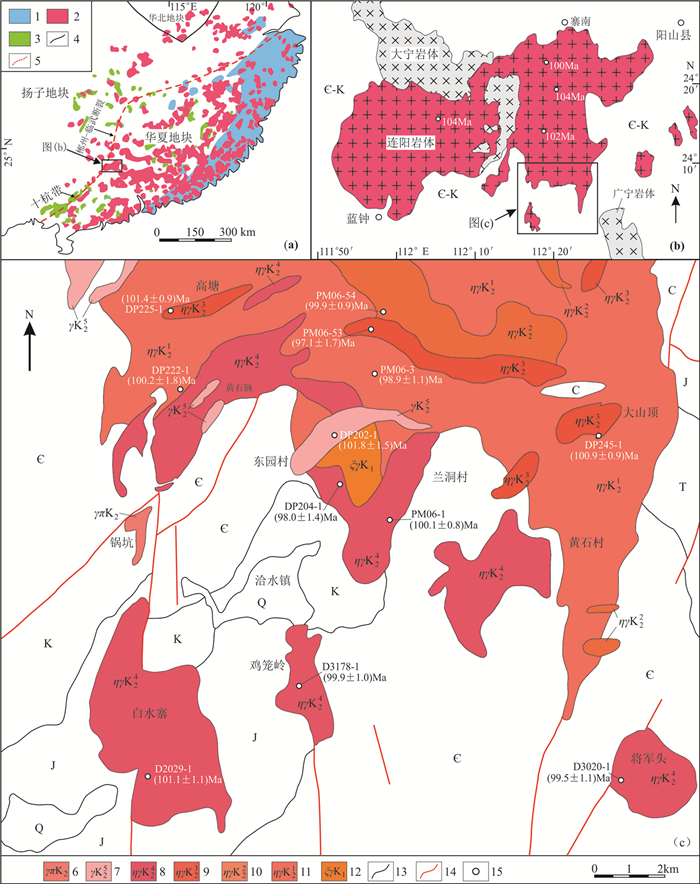
 下载:
下载:
